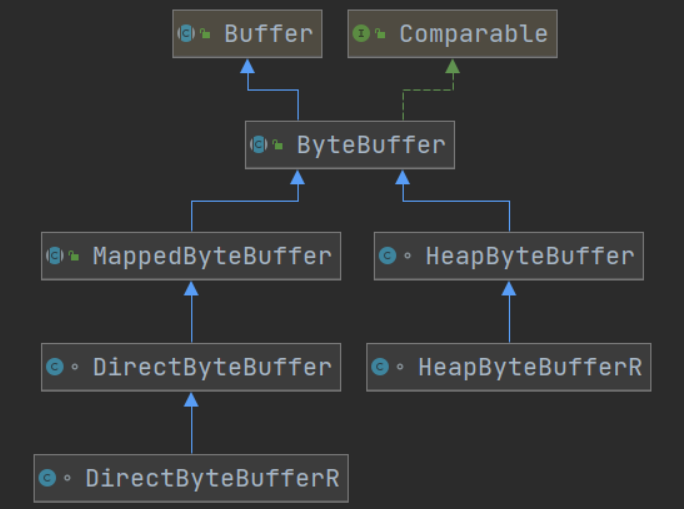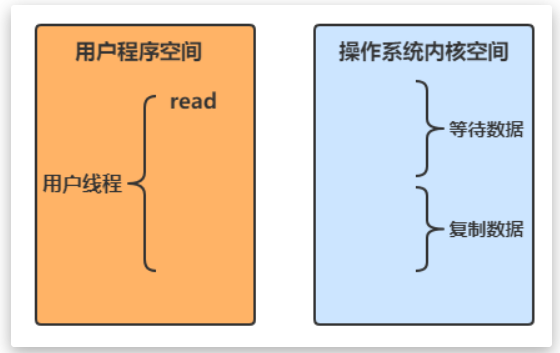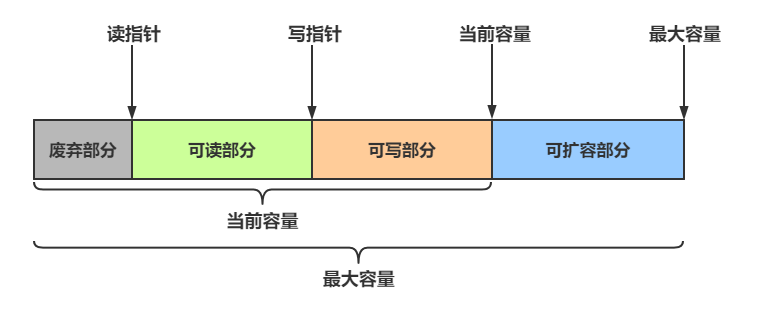1、三大组件简介
1.1、Channel与Buffer
Java NIO系统的核心在于:通道(Channel)和缓冲区(Buffer)。通道表示打开到 IO 设备(例如:文件、套接字)的连接。若需要使用 NIO 系统,需要获取用于连接 IO 设备的通道以及用于容纳数据的缓冲区。然后操作缓冲区,对数据进行处理
简而言之,通道负责传输,缓冲区负责存储
常见的Channel有以下四种,其中FileChannel主要用于文件传输,其余三种用于网络通信
- FileChannel
- DatagramChannel
- SocketChannel
- ServerSocketChannel
Buffer有以下几种,其中使用较多的是ByteBuffer
- ByteBuffer
- MappedByteBuffer
- DirectByteBuffer
- HeapByteBuffer
- ShortBuffer
- IntBuffer
- LongBuffer
- FloatBuffer
- DoubleBuffer
- CharBuffer
1.2、Selector
在使用Selector之前,处理socket连接还有以下两种方法
使用多线程技术
为每个连接分别开辟一个线程,分别去处理对应的socke连接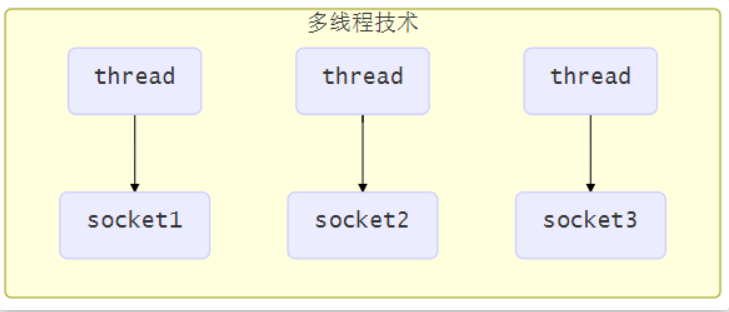
这种方法存在以下几个问题
- 内存占用高
- 每个线程都需要占用一定的内存,当连接较多时,会开辟大量线程,导致占用大量内存
- 线程上下文切换成本高
- 只适合连接数少的场景
- 连接数过多,会导致创建很多线程,从而出现问题
使用线程池技术
使用线程池,让线程池中的线程去处理连接
这种方法存在以下几个问题
- 阻塞模式下,线程仅能处理一个连接
- 线程池中的线程获取任务(task)后,只有当其执行完任务之后(断开连接后),才会去获取并执行下一个任务
- 若socke连接一直未断开,则其对应的线程无法处理其他socke连接
- 仅适合短连接场景
- 短连接即建立连接发送请求并响应后就立即断开,使得线程池中的线程可以快速处理其他连接
使用选择器
selector 的作用就是配合一个线程来管理多个 channel(fileChannel因为是阻塞式的,所以无法使用selector),获取这些 channel 上发生的事件,这些 channel 工作在非阻塞模式下,当一个channel中没有执行任务时,可以去执行其他channel中的任务。适合连接数多,但流量较少的场景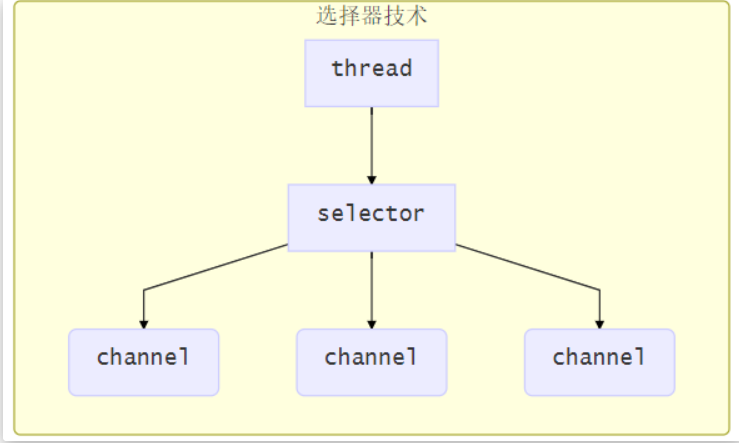
若事件未就绪,调用 selector 的 select() 方法会阻塞线程,直到 channel 发生了就绪事件。这些事件就绪后,select 方法就会返回这些事件交给 thread 来处理
1.3、ByteBuffer
1、使用案例
使用方式
- 向 buffer 写入数据,例如调用 channel.read(buffer)
- 调用 flip() 切换至读模式
- flip会使得buffer中的limit变为position,position变为0
- 从 buffer 读取数据,例如调用 buffer.get()
- 调用 clear() 或者compact()切换至写模式
- 调用clear()方法时position=0,limit变为capacity
- 调用compact()方法时,会将缓冲区中的未读数据压缩到缓冲区前面
- 重复以上步骤
使用ByteBuffer读取文件中的内容
public class TestByteBuffer {public static void main(String[] args) {// 获得FileChanneltry (FileChannel channel = new FileInputStream("stu.txt").getChannel()) {// 获得缓冲区ByteBuffer buffer = ByteBuffer.allocate(10);int hasNext = 0;StringBuilder builder = new StringBuilder();while((hasNext = channel.read(buffer)) > 0) {// 切换模式 limit=position, position=0buffer.flip();// 当buffer中还有数据时,获取其中的数据while(buffer.hasRemaining()) {builder.append((char)buffer.get());}// 切换模式 position=0, limit=capacitybuffer.clear();}System.out.println(builder.toString());} catch (IOException e) {}}}
2、核心属性
字节缓冲区的父类Buffer中有几个核心属性,如下
// Invariants: mark <= position <= limit <= capacityprivate int mark = -1;private int position = 0;private int limit;private int capacity;
- apacity:缓冲区的容量。通过构造函数赋予,一旦设置,无法更改
- limit:缓冲区的界限。位于limit 后的数据不可读写。缓冲区的限制不能为负,并且不能大于其容量
- position:下一个读写位置的索引(类似PC)。缓冲区的位置不能为负,并且不能大于limit
- mark:记录当前position的值。position被改变后,可以通过调用reset() 方法恢复到mark的位置。
以上四个属性必须满足以下要求
mark <= position <= limit <= capacity
3、核心方法
put()方法
- put()方法可以将一个数据放入到缓冲区中。
- 进行该操作后,postition的值会+1,指向下一个可以放入的位置。capacity = limit ,为缓冲区容量的值。
flip()方法
- flip()方法会切换对缓冲区的操作模式,由写->读 / 读->写
- 进行该操作后
- 如果是写模式->读模式,position = 0 , limit 指向最后一个元素的下一个位置,capacity不变
- 如果是读->写,则恢复为put()方法中的值
get()方法
- get()方法会读取缓冲区中的一个值
- 进行该操作后,position会+1,如果超过了limit则会抛出异常
- 注意:get(i)方法不会改变position的值
rewind()方法
- 该方法只能在读模式下使用
- rewind()方法后,会恢复position、limit和capacity的值,变为进行get()前的值
clean()方法
- clean()方法会将缓冲区中的各个属性恢复为最初的状态,position = 0, capacity = limit
- 此时缓冲区的数据依然存在,处于“被遗忘”状态,下次进行写操作时会覆盖这些数据
mark()和reset()方法
- mark()方法会将postion的值保存到mark属性中
reset()方法会将position的值改为mark中保存的值
compact()方法
此方法为ByteBuffer的方法,而不是Buffer的方法
compact会把未读完的数据向前压缩,然后切换到写模式
- 数据前移后,原位置的值并未清零,写时会覆盖之前的值
clear() VS compact()
clear只是对position、limit、mark进行重置,而compact在对position进行设置,以及limit、mark进行重置的同时,还涉及到数据在内存中拷贝(会调用arraycopy)。所以compact比clear更耗性能。但compact能保存你未读取的数据,将新数据追加到为读取的数据之后;而clear则不行,若你调用了clear,则未读取的数据就无法再读取到了
所以需要根据情况来判断使用哪种方法进行模式切换
4、方法调用及演示
ByteBuffer调试工具类
需要先导入netty依赖
<dependency><groupId>io.netty</groupId><artifactId>netty-all</artifactId><version>4.1.51.Final</version></dependency>
import java.nio.ByteBuffer;import io.netty.util.internal.MathUtil;import io.netty.util.internal.StringUtil;import io.netty.util.internal.MathUtil.*;/*** @author Panwen Chen* @date 2021/4/12 15:59*/public class ByteBufferUtil {private static final char[] BYTE2CHAR = new char[256];private static final char[] HEXDUMP_TABLE = new char[256 * 4];private static final String[] HEXPADDING = new String[16];private static final String[] HEXDUMP_ROWPREFIXES = new String[65536 >>> 4];private static final String[] BYTE2HEX = new String[256];private static final String[] BYTEPADDING = new String[16];static {final char[] DIGITS = "0123456789abcdef".toCharArray();for (int i = 0; i < 256; i++) {HEXDUMP_TABLE[i << 1] = DIGITS[i >>> 4 & 0x0F];HEXDUMP_TABLE[(i << 1) + 1] = DIGITS[i & 0x0F];}int i;// Generate the lookup table for hex dump paddingsfor (i = 0; i < HEXPADDING.length; i++) {int padding = HEXPADDING.length - i;StringBuilder buf = new StringBuilder(padding * 3);for (int j = 0; j < padding; j++) {buf.append(" ");}HEXPADDING[i] = buf.toString();}// Generate the lookup table for the start-offset header in each row (up to 64KiB).for (i = 0; i < HEXDUMP_ROWPREFIXES.length; i++) {StringBuilder buf = new StringBuilder(12);buf.append(StringUtil.NEWLINE);buf.append(Long.toHexString(i << 4 & 0xFFFFFFFFL | 0x100000000L));buf.setCharAt(buf.length() - 9, '|');buf.append('|');HEXDUMP_ROWPREFIXES[i] = buf.toString();}// Generate the lookup table for byte-to-hex-dump conversionfor (i = 0; i < BYTE2HEX.length; i++) {BYTE2HEX[i] = ' ' + StringUtil.byteToHexStringPadded(i);}// Generate the lookup table for byte dump paddingsfor (i = 0; i < BYTEPADDING.length; i++) {int padding = BYTEPADDING.length - i;StringBuilder buf = new StringBuilder(padding);for (int j = 0; j < padding; j++) {buf.append(' ');}BYTEPADDING[i] = buf.toString();}// Generate the lookup table for byte-to-char conversionfor (i = 0; i < BYTE2CHAR.length; i++) {if (i <= 0x1f || i >= 0x7f) {BYTE2CHAR[i] = '.';} else {BYTE2CHAR[i] = (char) i;}}}/*** 打印所有内容* @param buffer*/public static void debugAll(ByteBuffer buffer) {int oldlimit = buffer.limit();buffer.limit(buffer.capacity());StringBuilder origin = new StringBuilder(256);appendPrettyHexDump(origin, buffer, 0, buffer.capacity());System.out.println("+--------+-------------------- all ------------------------+----------------+");System.out.printf("position: [%d], limit: [%d]\n", buffer.position(), oldlimit);System.out.println(origin);buffer.limit(oldlimit);}/*** 打印可读取内容* @param buffer*/public static void debugRead(ByteBuffer buffer) {StringBuilder builder = new StringBuilder(256);appendPrettyHexDump(builder, buffer, buffer.position(), buffer.limit() - buffer.position());System.out.println("+--------+-------------------- read -----------------------+----------------+");System.out.printf("position: [%d], limit: [%d]\n", buffer.position(), buffer.limit());System.out.println(builder);}private static void appendPrettyHexDump(StringBuilder dump, ByteBuffer buf, int offset, int length) {if (MathUtil.isOutOfBounds(offset, length, buf.capacity())) {throw new IndexOutOfBoundsException("expected: " + "0 <= offset(" + offset + ") <= offset + length(" + length+ ") <= " + "buf.capacity(" + buf.capacity() + ')');}if (length == 0) {return;}dump.append(" +-------------------------------------------------+" +StringUtil.NEWLINE + " | 0 1 2 3 4 5 6 7 8 9 a b c d e f |" +StringUtil.NEWLINE + "+--------+-------------------------------------------------+----------------+");final int startIndex = offset;final int fullRows = length >>> 4;final int remainder = length & 0xF;// Dump the rows which have 16 bytes.for (int row = 0; row < fullRows; row++) {int rowStartIndex = (row << 4) + startIndex;// Per-row prefix.appendHexDumpRowPrefix(dump, row, rowStartIndex);// Hex dumpint rowEndIndex = rowStartIndex + 16;for (int j = rowStartIndex; j < rowEndIndex; j++) {dump.append(BYTE2HEX[getUnsignedByte(buf, j)]);}dump.append(" |");// ASCII dumpfor (int j = rowStartIndex; j < rowEndIndex; j++) {dump.append(BYTE2CHAR[getUnsignedByte(buf, j)]);}dump.append('|');}// Dump the last row which has less than 16 bytes.if (remainder != 0) {int rowStartIndex = (fullRows << 4) + startIndex;appendHexDumpRowPrefix(dump, fullRows, rowStartIndex);// Hex dumpint rowEndIndex = rowStartIndex + remainder;for (int j = rowStartIndex; j < rowEndIndex; j++) {dump.append(BYTE2HEX[getUnsignedByte(buf, j)]);}dump.append(HEXPADDING[remainder]);dump.append(" |");// Ascii dumpfor (int j = rowStartIndex; j < rowEndIndex; j++) {dump.append(BYTE2CHAR[getUnsignedByte(buf, j)]);}dump.append(BYTEPADDING[remainder]);dump.append('|');}dump.append(StringUtil.NEWLINE +"+--------+-------------------------------------------------+----------------+");}private static void appendHexDumpRowPrefix(StringBuilder dump, int row, int rowStartIndex) {if (row < HEXDUMP_ROWPREFIXES.length) {dump.append(HEXDUMP_ROWPREFIXES[row]);} else {dump.append(StringUtil.NEWLINE);dump.append(Long.toHexString(rowStartIndex & 0xFFFFFFFFL | 0x100000000L));dump.setCharAt(dump.length() - 9, '|');dump.append('|');}}public static short getUnsignedByte(ByteBuffer buffer, int index) {return (short) (buffer.get(index) & 0xFF);}}
调用ByteBuffer的方法
public class TestByteBuffer {public static void main(String[] args) {ByteBuffer buffer = ByteBuffer.allocate(10);// 向buffer中写入1个字节的数据buffer.put((byte)97);// 使用工具类,查看buffer状态ByteBufferUtil.debugAll(buffer);// 向buffer中写入4个字节的数据buffer.put(new byte[]{98, 99, 100, 101});ByteBufferUtil.debugAll(buffer);// 获取数据buffer.flip();ByteBufferUtil.debugAll(buffer);System.out.println(buffer.get());System.out.println(buffer.get());ByteBufferUtil.debugAll(buffer);// 使用compact切换模式buffer.compact();ByteBufferUtil.debugAll(buffer);// 再次写入buffer.put((byte)102);buffer.put((byte)103);ByteBufferUtil.debugAll(buffer);}}
结果
// 向缓冲区写入了一个字节的数据,此时postition为1+--------+-------------------- all ------------------------+----------------+position: [1], limit: [10]+-------------------------------------------------+| 0 1 2 3 4 5 6 7 8 9 a b c d e f |+--------+-------------------------------------------------+----------------+|00000000| 61 00 00 00 00 00 00 00 00 00 |a......... |+--------+-------------------------------------------------+----------------+// 向缓冲区写入四个字节的数据,此时position为5+--------+-------------------- all ------------------------+----------------+position: [5], limit: [10]+-------------------------------------------------+| 0 1 2 3 4 5 6 7 8 9 a b c d e f |+--------+-------------------------------------------------+----------------+|00000000| 61 62 63 64 65 00 00 00 00 00 |abcde..... |+--------+-------------------------------------------------+----------------+// 调用flip切换模式,此时position为0,表示从第0个数据开始读取+--------+-------------------- all ------------------------+----------------+position: [0], limit: [5]+-------------------------------------------------+| 0 1 2 3 4 5 6 7 8 9 a b c d e f |+--------+-------------------------------------------------+----------------+|00000000| 61 62 63 64 65 00 00 00 00 00 |abcde..... |+--------+-------------------------------------------------+----------------+// 读取两个字节的数据9798// position变为2+--------+-------------------- all ------------------------+----------------+position: [2], limit: [5]+-------------------------------------------------+| 0 1 2 3 4 5 6 7 8 9 a b c d e f |+--------+-------------------------------------------------+----------------+|00000000| 61 62 63 64 65 00 00 00 00 00 |abcde..... |+--------+-------------------------------------------------+----------------+// 调用compact切换模式,此时position及其后面的数据被压缩到ByteBuffer前面去了// 此时position为3,会覆盖之前的数据+--------+-------------------- all ------------------------+----------------+position: [3], limit: [10]+-------------------------------------------------+| 0 1 2 3 4 5 6 7 8 9 a b c d e f |+--------+-------------------------------------------------+----------------+|00000000| 63 64 65 64 65 00 00 00 00 00 |cdede..... |+--------+-------------------------------------------------+----------------+// 再次写入两个字节的数据,之前的 0x64 0x65 被覆盖+--------+-------------------- all ------------------------+----------------+position: [5], limit: [10]+-------------------------------------------------+| 0 1 2 3 4 5 6 7 8 9 a b c d e f |+--------+-------------------------------------------------+----------------+|00000000| 63 64 65 66 67 00 00 00 00 00 |cdefg..... |+--------+-------------------------------------------------+----------------+
5、字符串与ByteBuffer相互转换
方法一
编码:字符串调用getByte方法获得byte数组,将byte数组放入ByteBuffer中
解码:先调用ByteBuffer的flip方法,然后通过StandardCharsets的decoder方法解码
public class Translate {public static void main(String[] args) {// 准备两个字符串String str1 = "hello";String str2 = "";ByteBuffer buffer1 = ByteBuffer.allocate(16);// 通过字符串的getByte方法获得字节数组,放入缓冲区中buffer1.put(str1.getBytes());ByteBufferUtil.debugAll(buffer1);// 将缓冲区中的数据转化为字符串// 切换模式buffer1.flip();// 通过StandardCharsets解码,获得CharBuffer,再通过toString获得字符串str2 = StandardCharsets.UTF_8.decode(buffer1).toString();System.out.println(str2);ByteBufferUtil.debugAll(buffer1);}}
运行结果
+--------+-------------------- all ------------------------+----------------+position: [5], limit: [16]+-------------------------------------------------+| 0 1 2 3 4 5 6 7 8 9 a b c d e f |+--------+-------------------------------------------------+----------------+|00000000| 68 65 6c 6c 6f 00 00 00 00 00 00 00 00 00 00 00 |hello...........|+--------+-------------------------------------------------+----------------+hello+--------+-------------------- all ------------------------+----------------+position: [5], limit: [5]+-------------------------------------------------+| 0 1 2 3 4 5 6 7 8 9 a b c d e f |+--------+-------------------------------------------------+----------------+|00000000| 68 65 6c 6c 6f 00 00 00 00 00 00 00 00 00 00 00 |hello...........|+--------+-------------------------------------------------+----------------+
方法二
编码:通过StandardCharsets的encode方法获得ByteBuffer,此时获得的ByteBuffer为读模式,无需通过flip切换模式
解码:通过StandardCharsets的decoder方法解码
public class Translate {public static void main(String[] args) {// 准备两个字符串String str1 = "hello";String str2 = "";// 通过StandardCharsets的encode方法获得ByteBuffer// 此时获得的ByteBuffer为读模式,无需通过flip切换模式ByteBuffer buffer1 = StandardCharsets.UTF_8.encode(str1);ByteBufferUtil.debugAll(buffer1);// 将缓冲区中的数据转化为字符串// 通过StandardCharsets解码,获得CharBuffer,再通过toString获得字符串str2 = StandardCharsets.UTF_8.decode(buffer1).toString();System.out.println(str2);ByteBufferUtil.debugAll(buffer1);}}
运行结果
+--------+-------------------- all ------------------------+----------------+position: [0], limit: [5]+-------------------------------------------------+| 0 1 2 3 4 5 6 7 8 9 a b c d e f |+--------+-------------------------------------------------+----------------+|00000000| 68 65 6c 6c 6f |hello |+--------+-------------------------------------------------+----------------+hello+--------+-------------------- all ------------------------+----------------+position: [5], limit: [5]+-------------------------------------------------+| 0 1 2 3 4 5 6 7 8 9 a b c d e f |+--------+-------------------------------------------------+----------------+|00000000| 68 65 6c 6c 6f |hello |+--------+-------------------------------------------------+----------------+
方法三
编码:字符串调用getByte()方法获得字节数组,将字节数组传给ByteBuffer的wrap()方法,通过该方法获得ByteBuffer。同样无需调用flip方法切换为读模式
解码:通过StandardCharsets的decoder方法解码
public class Translate {public static void main(String[] args) {// 准备两个字符串String str1 = "hello";String str2 = "";// 通过StandardCharsets的encode方法获得ByteBuffer// 此时获得的ByteBuffer为读模式,无需通过flip切换模式ByteBuffer buffer1 = ByteBuffer.wrap(str1.getBytes());ByteBufferUtil.debugAll(buffer1);// 将缓冲区中的数据转化为字符串// 通过StandardCharsets解码,获得CharBuffer,再通过toString获得字符串str2 = StandardCharsets.UTF_8.decode(buffer1).toString();System.out.println(str2);ByteBufferUtil.debugAll(buffer1);}}
运行结果
+--------+-------------------- all ------------------------+----------------+position: [0], limit: [5]+-------------------------------------------------+| 0 1 2 3 4 5 6 7 8 9 a b c d e f |+--------+-------------------------------------------------+----------------+|00000000| 68 65 6c 6c 6f |hello |+--------+-------------------------------------------------+----------------+hello+--------+-------------------- all ------------------------+----------------+position: [5], limit: [5]+-------------------------------------------------+| 0 1 2 3 4 5 6 7 8 9 a b c d e f |+--------+-------------------------------------------------+----------------+|00000000| 68 65 6c 6c 6f |hello |+--------+-------------------------------------------------+----------------+
6、粘包与半包
现象
网络上有多条数据发送给服务端,数据之间使用 \n 进行分隔
但由于某种原因这些数据在接收时,被进行了重新组合,例如原始数据有3条为
- Hello,world\n
- I’m Nyima\n
- How are you?\n
变成了下面的两个 byteBuffer (粘包,半包)
- Hello,world\nI’m Nyima\nHo
- w are you?\n
出现原因
粘包
发送方在发送数据时,并不是一条一条地发送数据,而是将数据整合在一起,当数据达到一定的数量后再一起发送。这就会导致多条信息被放在一个缓冲区中被一起发送出去
半包
接收方的缓冲区的大小是有限的,当接收方的缓冲区满了以后,就需要将信息截断,等缓冲区空了以后再继续放入数据。这就会发生一段完整的数据最后被截断的现象
解决办法
- 通过get(index)方法遍历ByteBuffer,遇到分隔符时进行处理。注意:get(index)不会改变position的值
- 记录该段数据长度,以便于申请对应大小的缓冲区
- 将缓冲区的数据通过get()方法写入到target中
调用compact方法切换模式,因为缓冲区中可能还有未读的数据
public class ByteBufferDemo {public static void main(String[] args) {ByteBuffer buffer = ByteBuffer.allocate(32);// 模拟粘包+半包buffer.put("Hello,world\nI'm Nyima\nHo".getBytes());// 调用split函数处理split(buffer);buffer.put("w are you?\n".getBytes());split(buffer);}private static void split(ByteBuffer buffer) {// 切换为读模式buffer.flip();for(int i = 0; i < buffer.limit(); i++) {// 遍历寻找分隔符// get(i)不会移动positionif (buffer.get(i) == '\n') {// 缓冲区长度int length = i+1-buffer.position();ByteBuffer target = ByteBuffer.allocate(length);// 将前面的内容写入target缓冲区for(int j = 0; j < length; j++) {// 将buffer中的数据写入target中target.put(buffer.get());}// 打印查看结果ByteBufferUtil.debugAll(target);}}// 切换为写模式,但是缓冲区可能未读完,这里需要使用compactbuffer.compact();}}
+--------+-------------------- all ------------------------+----------------+position: [12], limit: [12]+-------------------------------------------------+| 0 1 2 3 4 5 6 7 8 9 a b c d e f |+--------+-------------------------------------------------+----------------+|00000000| 48 65 6c 6c 6f 2c 77 6f 72 6c 64 0a |Hello,world. |+--------+-------------------------------------------------+----------------++--------+-------------------- all ------------------------+----------------+position: [10], limit: [10]+-------------------------------------------------+| 0 1 2 3 4 5 6 7 8 9 a b c d e f |+--------+-------------------------------------------------+----------------+|00000000| 49 27 6d 20 4e 79 69 6d 61 0a |I'm Nyima. |+--------+-------------------------------------------------+----------------++--------+-------------------- all ------------------------+----------------+position: [13], limit: [13]+-------------------------------------------------+| 0 1 2 3 4 5 6 7 8 9 a b c d e f |+--------+-------------------------------------------------+----------------+|00000000| 48 6f 77 20 61 72 65 20 79 6f 75 3f 0a |How are you?. |+--------+-------------------------------------------------+----------------+
2、文件编程
2.1、FileChannel
1、工作模式
FileChannel只能在阻塞模式下工作,所以无法搭配Selector
2、获取
不能直接打开 FileChannel,必须通过 FileInputStream、FileOutputStream 或者 RandomAccessFile 来获取 FileChannel,它们都有 getChannel 方法
通过 FileInputStream 获取的 channel 只能读
- 通过 FileOutputStream 获取的 channel 只能写
通过 RandomAccessFile 是否能读写根据构造 RandomAccessFile 时的读写模式决定
3、读取
通过 FileInputStream 获取channel,通过read方法将数据写入到ByteBuffer中read方法的返回值表示读到了多少字节,若读到了文件末尾则返回-1。
int readBytes = channel.read(buffer);
可根据返回值判断是否读取完毕
while(channel.read(buffer) > 0) {// 进行对应操作...}
4、写入
因为channel也是有大小的,所以 write 方法并不能保证一次将 buffer 中的内容全部写入 channel。必须需要按照以下规则进行写入
// 通过hasRemaining()方法查看缓冲区中是否还有数据未写入到通道中while(buffer.hasRemaining()) {channel.write(buffer);}
5、关闭
通道需要close,一般情况通过try-with-resource进行关闭,最好使用以下方法获取strea以及channel,避免某些原因使得资源未被关闭
public class TestChannel {public static void main(String[] args) throws IOException {try (FileInputStream fis = new FileInputStream("stu.txt");FileOutputStream fos = new FileOutputStream("student.txt");FileChannel inputChannel = fis.getChannel();FileChannel outputChannel = fos.getChannel()) {// 执行对应操作...}}}
6、位置
position
channel也拥有一个保存读取数据位置的属性,即positionlong pos = channel.position();
可以通过position(int pos)设置channel中position的值
long newPos = ...;channel.position(newPos);
设置当前位置时,如果设置为文件的末尾
这时读取会返回 -1
这时写入,会追加内容,但要注意如果 position 超过了文件末尾,再写入时在新内容和原末尾之间会有空洞(00)
7、强制写入
操作系统出于性能的考虑,会将数据缓存,不是立刻写入磁盘,而是等到缓存满了以后将所有数据一次性的写入磁盘。可以调用 force(true) 方法将文件内容和元数据(文件的权限等信息)立刻写入磁盘
2.2、Channel之间传输数据
1、transferTo方法
使用transferTo方法可以快速、高效地将一个channel中的数据传输到另一个channel中,但一次只能传输2G的内容
transferTo底层使用了零拷贝技术
什么叫零拷贝技术? // TODOpublic class TestChannel {public static void main(String[] args){try (FileInputStream fis = new FileInputStream("stu.txt");FileOutputStream fos = new FileOutputStream("student.txt");FileChannel inputChannel = fis.getChannel();FileChannel outputChannel = fos.getChannel()) {// 参数:inputChannel的起始位置,传输数据的大小,目的channel// 返回值为传输的数据的字节数// transferTo一次只能传输2G的数据inputChannel.transferTo(0, inputChannel.size(), outputChannel);} catch (IOException e) {e.printStackTrace();}}}
当传输的文件大于2G时,需要使用以下方法进行多次传输
public class TestChannel {public static void main(String[] args){try (FileInputStream fis = new FileInputStream("stu.txt");FileOutputStream fos = new FileOutputStream("student.txt");FileChannel inputChannel = fis.getChannel();FileChannel outputChannel = fos.getChannel()) {long size = inputChannel.size();long capacity = inputChannel.size();// 分多次传输while (capacity > 0) {// transferTo返回值为传输了的字节数capacity -= inputChannel.transferTo(size-capacity, capacity, outputChannel);}} catch (IOException e) {e.printStackTrace();}}}
2.3、Path与Paths
Path 用来表示文件路径
- Paths 是工具类,用来获取 Path 实例 ```java Path source = Paths.get(“1.txt”); // 相对路径 不带盘符 使用 user.dir 环境变量来定位 1.txt
Path source = Paths.get(“d:\1.txt”); // 绝对路径 代表了 d:\1.txt 反斜杠需要转义
Path source = Paths.get(“d:/1.txt”); // 绝对路径 同样代表了 d:\1.txt
Path projects = Paths.get(“d:\data”, “projects”); // 代表了 d:\data\projects
- . 代表了当前路径- .. 代表了上一级路径```javaPath path = Paths.get("d:\\data\\projects\\a\\..\\b");System.out.println(path);System.out.println(path.normalize()); // 正常化路径 会去除 . 以及 ..
d:\data\projects\a\..\bd:\data\projects\b
2.4、Files
1、查找
检查文件是否存在
Path path = Paths.get("helloword/data.txt");System.out.println(Files.exists(path));、
2、创建
创建一级目录
Path path = Paths.get("helloword/d1");Files.createDirectory(path);
- 如果目录已存在,会抛异常 FileAlreadyExistsException
- 不能一次创建多级目录,否则会抛异常 NoSuchFileException
创建多级目录用
Path path = Paths.get("helloword/d1/d2");Files.createDirectories(path);
3、拷贝及移动
拷贝文件
Path source = Paths.get("helloword/data.txt");Path target = Paths.get("helloword/target.txt");Files.copy(source, target);
- 如果文件已存在,会抛异常 FileAlreadyExistsException
如果希望用 source 覆盖掉 target,需要用 StandardCopyOption 来控制
Files.copy(source, target, StandardCopyOption.REPLACE_EXISTING);
移动文件
Path source = Paths.get("helloword/data.txt");Path target = Paths.get("helloword/data.txt");Files.move(source, target, StandardCopyOption.ATOMIC_MOVE);
- StandardCopyOption.ATOMIC_MOVE 保证文件移动的原子性
4、删除
删除文件 ```java Path target = Paths.get(“helloword/target.txt”);
Files.delete(target);
- 如果文件不存在,会抛异常 NoSuchFileException删除目录```javaPath target = Paths.get("helloword/d1");Files.delete(target);
- 如果目录还有内容,会抛异常 DirectoryNotEmptyException
需要删除的话需要通过判断是否为目录然后进入目录进行删除文件循环删除。
5、遍历
可以使用Files工具类中的walkFileTree(Path, FileVisitor)方法,其中需要传入两个参数
Path:文件起始路径
FileVisitor:文件访问器,使用访问者模式
接口的实现类SimpleFileVisitor有四个方法
- preVisitDirectory:访问目录前的操作
- visitFile:访问文件的操作
- visitFileFailed:访问文件失败时的操作
postVisitDirectory:访问目录后的操作
public class TestWalkFileTree {public static void main(String[] args) throws IOException {Path path = Paths.get("F:\\JDK 8");// 文件目录数目AtomicInteger dirCount = new AtomicInteger();// 文件数目AtomicInteger fileCount = new AtomicInteger();Files.walkFileTree(path, new SimpleFileVisitor<Path>(){@Overridepublic FileVisitResult preVisitDirectory(Path dir, BasicFileAttributes attrs) throws IOException {System.out.println("===>"+dir);// 增加文件目录数dirCount.incrementAndGet();return super.preVisitDirectory(dir, attrs);}@Overridepublic FileVisitResult visitFile(Path file, BasicFileAttributes attrs) throws IOException {System.out.println(file);// 增加文件数fileCount.incrementAndGet();return super.visitFile(file, attrs);}});// 打印数目System.out.println("文件目录数:"+dirCount.get());System.out.println("文件数:"+fileCount.get());}}
运行结果如下
...===>F:\JDK 8\lib\security\policy\unlimitedF:\JDK 8\lib\security\policy\unlimited\local_policy.jarF:\JDK 8\lib\security\policy\unlimited\US_export_policy.jarF:\JDK 8\lib\security\trusted.librariesF:\JDK 8\lib\sound.propertiesF:\JDK 8\lib\tzdb.datF:\JDK 8\lib\tzmappingsF:\JDK 8\LICENSEF:\JDK 8\README.txtF:\JDK 8\releaseF:\JDK 8\THIRDPARTYLICENSEREADME-JAVAFX.txtF:\JDK 8\THIRDPARTYLICENSEREADME.txtF:\JDK 8\Welcome.html文件目录数:23文件数:279
3、网络编程
3.1、阻塞
阻塞模式下,相关方法都会导致线程暂停
- ServerSocketChannel.accept 会在没有连接建立时让线程暂停
- SocketChannel.read 会在通道中没有数据可读时让线程暂停
- 阻塞的表现其实就是线程暂停了,暂停期间不会占用 cpu,但线程相当于闲置
- 单线程下,阻塞方法之间相互影响,几乎不能正常工作,需要多线程支持
- 但多线程下,有新的问题,体现在以下方面
- 32 位 jvm 一个线程 320k,64 位 jvm 一个线程 1024k,如果连接数过多,必然导致 OOM,并且线程太多,反而会因为频繁上下文切换导致性能降低
- 可以采用线程池技术来减少线程数和线程上下文切换,但治标不治本,如果有很多连接建立,但长时间 inactive,会阻塞线程池中所有线程,因此不适合长连接,只适合短连接
服务端代码
public class Server {public static void main(String[] args) {// 创建缓冲区ByteBuffer buffer = ByteBuffer.allocate(16);// 获得服务器通道try(ServerSocketChannel server = ServerSocketChannel.open()) {// 为服务器通道绑定端口server.bind(new InetSocketAddress(8080));// 用户存放连接的集合ArrayList<SocketChannel> channels = new ArrayList<>();// 循环接收连接while (true) {System.out.println("before connecting...");// 没有连接时,会阻塞线程SocketChannel socketChannel = server.accept();System.out.println("after connecting...");channels.add(socketChannel);// 循环遍历集合中的连接for(SocketChannel channel : channels) {System.out.println("before reading");// 处理通道中的数据// 当通道中没有数据可读时,会阻塞线程channel.read(buffer);buffer.flip();ByteBufferUtil.debugRead(buffer);buffer.clear();System.out.println("after reading");}}} catch (IOException e) {e.printStackTrace();}}}
客户端代码
public class Client {public static void main(String[] args) {try (SocketChannel socketChannel = SocketChannel.open()) {// 建立连接socketChannel.connect(new InetSocketAddress("localhost", 8080));System.out.println("waiting...");} catch (IOException e) {e.printStackTrace();}}}
运行结果
- 客户端-服务器建立连接前:服务器端因accept阻塞

- 客户端-服务器建立连接后,客户端发送消息前:服务器端因通道为空被阻塞
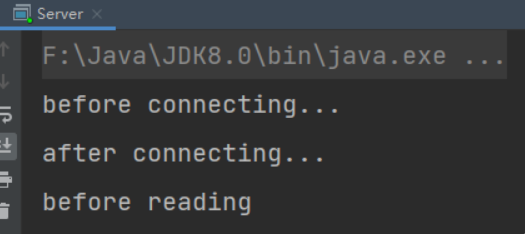
- 客户端发送数据后,服务器处理通道中的数据。再次进入循环时,再次被accept阻塞
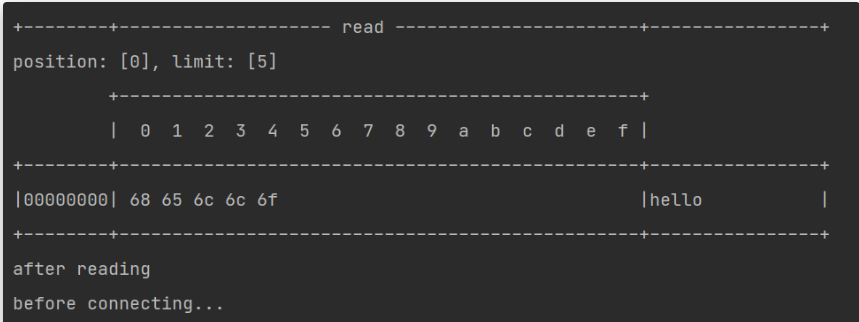
- 之前的客户端再次发送消息,服务器端因为被accept阻塞,无法处理之前客户端发送到通道中的信息
3.2、非阻塞
- 可以通过ServerSocketChannel的configureBlocking(false)方法将获得连接设置为非阻塞的。此时若没有连接,accept会返回null
- 可以通过SocketChannel的configureBlocking(false)方法将从通道中读取数据设置为非阻塞的。若此时通道中没有数据可读,read会返回-1
服务器代码如下
public class Server {public static void main(String[] args) {// 创建缓冲区ByteBuffer buffer = ByteBuffer.allocate(16);// 获得服务器通道try(ServerSocketChannel server = ServerSocketChannel.open()) {// 为服务器通道绑定端口server.bind(new InetSocketAddress(8080));// 用户存放连接的集合ArrayList<SocketChannel> channels = new ArrayList<>();// 循环接收连接while (true) {// 设置为非阻塞模式,没有连接时返回null,不会阻塞线程server.configureBlocking(false);SocketChannel socketChannel = server.accept();// 通道不为空时才将连接放入到集合中if (socketChannel != null) {System.out.println("after connecting...");channels.add(socketChannel);}// 循环遍历集合中的连接for(SocketChannel channel : channels) {// 处理通道中的数据// 设置为非阻塞模式,若通道中没有数据,会返回0,不会阻塞线程channel.configureBlocking(false);int read = channel.read(buffer);if(read > 0) {buffer.flip();ByteBufferUtil.debugRead(buffer);buffer.clear();System.out.println("after reading");}}}} catch (IOException e) {e.printStackTrace();}}}
这样写存在一个问题,因为设置为了非阻塞,会一直执行while(true)中的代码,CPU一直处于忙碌状态,会使得性能变低,所以实际情况中不使用这种方法处理请求
3.3、Selector
多路复用
单线程可以配合 Selector 完成对多个 Channel 可读写事件的监控,这称之为多路复用
- 多路复用仅针对网络 IO,普通文件 IO 无法利用多路复用
如果不用 Selector 的非阻塞模式,线程大部分时间都在做无用功,而 Selector 能够保证
- 有可连接事件时才去连接
- 有可读事件才去读取
有可写事件才去写入
限于网络传输能力,Channel 未必时时可写,一旦 Channel 可写,会触发 Selector 的可写事件
3.4、使用及Accpet事件
要使用Selector实现多路复用,服务端代码如下改进
public class SelectServer {public static void main(String[] args) {ByteBuffer buffer = ByteBuffer.allocate(16);// 获得服务器通道try(ServerSocketChannel server = ServerSocketChannel.open()) {server.bind(new InetSocketAddress(8080));// 创建选择器Selector selector = Selector.open();// 通道必须设置为非阻塞模式server.configureBlocking(false);// 将通道注册到选择器中,并设置感兴趣的事件server.register(selector, SelectionKey.OP_ACCEPT);while (true) {// 若没有事件就绪,线程会被阻塞,反之不会被阻塞。从而避免了CPU空转// 返回值为就绪的事件个数int ready = selector.select();System.out.println("selector ready counts : " + ready);// 获取所有事件Set<SelectionKey> selectionKeys = selector.selectedKeys();// 使用迭代器遍历事件Iterator<SelectionKey> iterator = selectionKeys.iterator();while (iterator.hasNext()) {SelectionKey key = iterator.next();// 判断key的类型if(key.isAcceptable()) {// 获得key对应的channelServerSocketChannel channel = (ServerSocketChannel) key.channel();System.out.println("before accepting...");// 获取连接并处理,而且是必须处理,否则需要取消SocketChannel socketChannel = channel.accept();System.out.println("after accepting...");// 处理完毕后移除iterator.remove();}}}} catch (IOException e) {e.printStackTrace();}}}
步骤解析
获得选择器Selector
Selector selector = Selector.open();
将通道设置为非阻塞模式,并注册到选择器中,并设置感兴趣的事件
- channel 必须工作在非阻塞模式
- FileChannel 没有非阻塞模式,因此不能配合 selector 一起使用
- 绑定的事件类型可以有
- connect - 客户端连接成功时触发
- accept - 服务器端成功接受连接时触发
- read - 数据可读入时触发,有因为接收能力弱,数据暂不能读入的情况
- write - 数据可写出时触发,有因为发送能力弱,数据暂不能写出的情况
// 通道必须设置为非阻塞模式server.configureBlocking(false);// 将通道注册到选择器中,并设置感兴趣的实践server.register(selector, SelectionKey.OP_ACCEPT);
通过Selector监听事件,并获得就绪的通道个数,若没有通道就绪,线程会被阻塞
阻塞直到绑定事件发生
int count = selector.select();
阻塞直到绑定事件发生,或是超时(时间单位为 ms)
int count = selector.select(long timeout);
不会阻塞,也就是不管有没有事件,立刻返回,自己根据返回值检查是否有事件
int count = selector.selectNow();
获取就绪事件并得到对应的通道,然后进行处理 ```java // 获取所有事件 Set
selectionKeys = selector.selectedKeys();
// 使用迭代器遍历事件
Iterator
while (iterator.hasNext()) { SelectionKey key = iterator.next();
// 判断key的类型,此处为Accept类型if(key.isAcceptable()) {// 获得key对应的channelServerSocketChannel channel = (ServerSocketChannel) key.channel();// 获取连接并处理,而且是必须处理,否则需要取消SocketChannel socketChannel = channel.accept();// 处理完毕后移除iterator.remove();}
}
**事件发生后能否不处理**<br />事件发生后,**要么处理,要么取消(cancel)**,不能什么都不做,**否则下次该事件仍会触发**,这是因为 nio 底层使用的是水平触发<a name="Ft6yS"></a>### 3.5、Read事件- 在Accept事件中,若有客户端与服务器端建立了连接,**需要将其对应的SocketChannel设置为非阻塞,并注册到选择其中**- 添加Read事件,触发后进行读取操作```javapublic class SelectServer {public static void main(String[] args) {ByteBuffer buffer = ByteBuffer.allocate(16);// 获得服务器通道try(ServerSocketChannel server = ServerSocketChannel.open()) {server.bind(new InetSocketAddress(8080));// 创建选择器Selector selector = Selector.open();// 通道必须设置为非阻塞模式server.configureBlocking(false);// 将通道注册到选择器中,并设置感兴趣的实践server.register(selector, SelectionKey.OP_ACCEPT);// 为serverKey设置感兴趣的事件while (true) {// 若没有事件就绪,线程会被阻塞,反之不会被阻塞。从而避免了CPU空转// 返回值为就绪的事件个数int ready = selector.select();System.out.println("selector ready counts : " + ready);// 获取所有事件Set<SelectionKey> selectionKeys = selector.selectedKeys();// 使用迭代器遍历事件Iterator<SelectionKey> iterator = selectionKeys.iterator();while (iterator.hasNext()) {SelectionKey key = iterator.next();// 判断key的类型if(key.isAcceptable()) {// 获得key对应的channelServerSocketChannel channel = (ServerSocketChannel) key.channel();System.out.println("before accepting...");// 获取连接SocketChannel socketChannel = channel.accept();System.out.println("after accepting...");// 设置为非阻塞模式,同时将连接的通道也注册到选择其中socketChannel.configureBlocking(false);socketChannel.register(selector, SelectionKey.OP_READ);// 处理完毕后移除iterator.remove();} else if (key.isReadable()) {SocketChannel channel = (SocketChannel) key.channel();System.out.println("before reading...");channel.read(buffer);System.out.println("after reading...");buffer.flip();ByteBufferUtil.debugRead(buffer);buffer.clear();// 处理完毕后移除iterator.remove();}}}} catch (IOException e) {e.printStackTrace();}}}
删除事件
当处理完一个事件后,一定要调用迭代器的remove方法移除对应事件,否则会出现错误。原因如下
以我们上面的 Read事件 的代码为例
当调用了 server.register(selector, SelectionKey.OP_ACCEPT)后,Selector中维护了一个集合,用于存放SelectionKey以及其对应的通道
// WindowsSelectorImpl 中的 SelectionKeyImpl数组private SelectionKeyImpl[] channelArray = new SelectionKeyImpl[8];
public class SelectionKeyImpl extends AbstractSelectionKey {// Key对应的通道final SelChImpl channel;...}
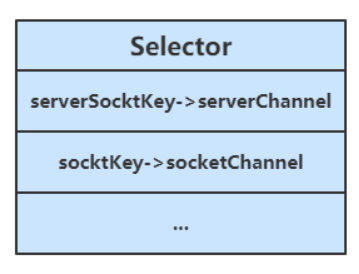
当选择器中的通道对应的事件发生后,selecionKey会被放到另一个集合中,但是selecionKey不会自动移除,所以需要我们在处理完一个事件后,通过迭代器手动移除其中的selecionKey。否则会导致已被处理过的事件再次被处理,就会引发错误
断开处理
当客户端与服务器之间的连接断开时,会给服务器端发送一个读事件,对异常断开和正常断开需要加以不同的方式进行处理
正常断开
- 正常断开时,服务器端的channel.read(buffer)方法的返回值为-1,所以当结束到返回值为-1时,需要调用key的cancel方法取消此事件,并在取消后移除该事件
int read = channel.read(buffer);// 断开连接时,客户端会向服务器发送一个写事件,此时read的返回值为-1if(read == -1) {// 取消该事件的处理key.cancel();channel.close();} else {...}// 取消或者处理,都需要移除keyiterator.remove();
- 正常断开时,服务器端的channel.read(buffer)方法的返回值为-1,所以当结束到返回值为-1时,需要调用key的cancel方法取消此事件,并在取消后移除该事件
异常断开
- 异常断开时,会抛出IOException异常, 在try-catch的catch块中捕获异常并调用key的cancel方法即可
消息边界
不处理消息边界存在的问题
将缓冲区的大小设置为4个字节,发送2个汉字(你好),通过decode解码并打印时,会出现乱码ByteBuffer buffer = ByteBuffer.allocate(4);// 解码并打印System.out.println(StandardCharsets.UTF_8.decode(buffer));
这是因为UTF-8字符集下,1个汉字占用3个字节,此时缓冲区大小为4个字节,一次读时间无法处理完通道中的所有数据,所以一共会触发两次读事件。这就导致 你好 的 好 字被拆分为了前半部分和后半部分发送,解码时就会出现问题你���
处理消息边界
传输的文本可能有以下三种情况
- 异常断开时,会抛出IOException异常, 在try-catch的catch块中捕获异常并调用key的cancel方法即可
文本大于缓冲区大小
- 此时需要将缓冲区进行扩容
- 发生半包现象
- 发生粘包现象
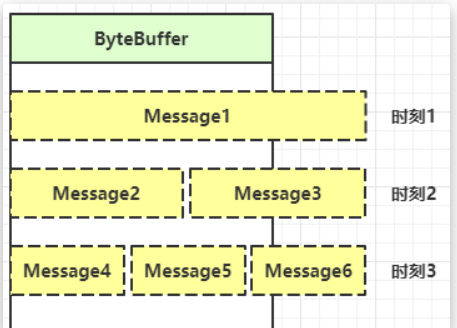
解决思路大致有以下三种
- 固定消息长度,数据包大小一样,服务器按预定长度读取,当发送的数据较少时,需要将数据进行填充,直到长度与消息规定长度一致。缺点是浪费带宽
- 另一种思路是按分隔符拆分,缺点是效率低,需要一个一个字符地去匹配分隔符
- TLV 格式,即 Type 类型、Length 长度、Value 数据(也就是在消息开头用一些空间存放后面数据的长度),如HTTP请求头中的Content-Type与Content-Length。类型和长度已知的情况下,就可以方便获取消息大小,分配合适的 buffer,缺点是 buffer 需要提前分配,如果内容过大,则影响 server 吞吐量
- Http 1.1 是 TLV 格式
- Http 2.0 是 LTV 格式
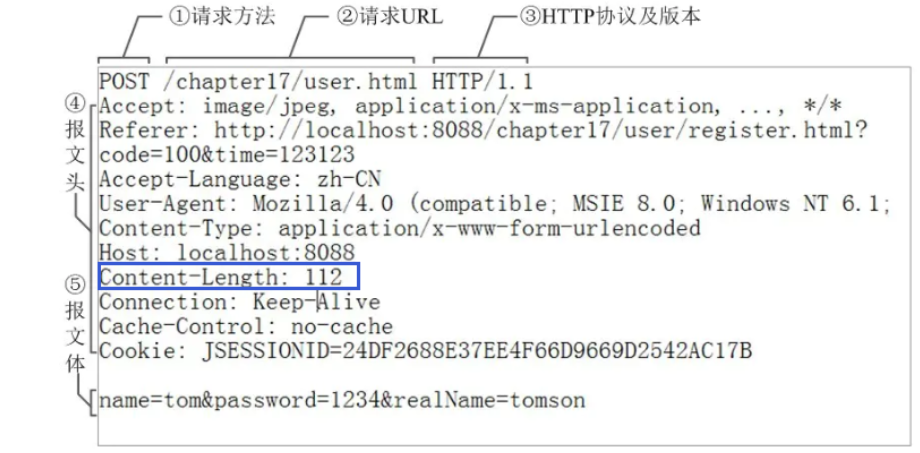
下文的消息边界处理方式为第二种:按分隔符拆分
附件与扩容
Channel的register方法还有第三个参数:附件,可以向其中放入一个Object类型的对象,该对象会与登记的Channel以及其对应的SelectionKey绑定,可以从SelectionKey获取到对应通道的附件
public final SelectionKey register(Selector sel, int ops, Object att)
可通过SelectionKey的attachment()方法获得附件
ByteBuffer buffer = (ByteBuffer) key.attachment();
我们需要在Accept事件发生后,将通道注册到Selector中时,对每个通道添加一个ByteBuffer附件,让每个通道发生读事件时都使用自己的通道,避免与其他通道发生冲突而导致问题
// 设置为非阻塞模式,同时将连接的通道也注册到选择其中,同时设置附件socketChannel.configureBlocking(false);ByteBuffer buffer = ByteBuffer.allocate(16);// 添加通道对应的Buffer附件socketChannel.register(selector, SelectionKey.OP_READ, buffer);
当Channel中的数据大于缓冲区时,需要对缓冲区进行扩容操作。此代码中的扩容的判定方法:Channel调用compact方法后,的position与limit相等,说明缓冲区中的数据并未被读取(容量太小),此时创建新的缓冲区,其大小扩大为两倍。同时还要将旧缓冲区中的数据拷贝到新的缓冲区中,同时调用SelectionKey的attach方法将新的缓冲区作为新的附件放入SelectionKey中
// 如果缓冲区太小,就进行扩容if (buffer.position() == buffer.limit()) {ByteBuffer newBuffer = ByteBuffer.allocate(buffer.capacity()*2);// 将旧buffer中的内容放入新的buffer中ewBuffer.put(buffer);// 将新buffer作为附件放到key中key.attach(newBuffer);}
改造后的服务器代码如下
public class SelectServer {public static void main(String[] args) {// 获得服务器通道try(ServerSocketChannel server = ServerSocketChannel.open()) {server.bind(new InetSocketAddress(8080));// 创建选择器Selector selector = Selector.open();// 通道必须设置为非阻塞模式server.configureBlocking(false);// 将通道注册到选择器中,并设置感兴趣的事件server.register(selector, SelectionKey.OP_ACCEPT);// 为serverKey设置感兴趣的事件while (true) {// 若没有事件就绪,线程会被阻塞,反之不会被阻塞。从而避免了CPU空转// 返回值为就绪的事件个数int ready = selector.select();System.out.println("selector ready counts : " + ready);// 获取所有事件Set<SelectionKey> selectionKeys = selector.selectedKeys();// 使用迭代器遍历事件Iterator<SelectionKey> iterator = selectionKeys.iterator();while (iterator.hasNext()) {SelectionKey key = iterator.next();// 判断key的类型if(key.isAcceptable()) {// 获得key对应的channelServerSocketChannel channel = (ServerSocketChannel) key.channel();System.out.println("before accepting...");// 获取连接SocketChannel socketChannel = channel.accept();System.out.println("after accepting...");// 设置为非阻塞模式,同时将连接的通道也注册到选择其中,同时设置附件socketChannel.configureBlocking(false);ByteBuffer buffer = ByteBuffer.allocate(16);socketChannel.register(selector, SelectionKey.OP_READ, buffer);// 处理完毕后移除iterator.remove();} else if (key.isReadable()) {SocketChannel channel = (SocketChannel) key.channel();System.out.println("before reading...");// 通过key获得附件(buffer)ByteBuffer buffer = (ByteBuffer) key.attachment();int read = channel.read(buffer);if(read == -1) {key.cancel();channel.close();} else {// 通过分隔符来分隔buffer中的数据split(buffer);// 如果缓冲区太小,就进行扩容if (buffer.position() == buffer.limit()) {ByteBuffer newBuffer = ByteBuffer.allocate(buffer.capacity()*2);// 将旧buffer中的内容放入新的buffer中buffer.flip();newBuffer.put(buffer);// 将新buffer放到key中作为附件key.attach(newBuffer);}}System.out.println("after reading...");// 处理完毕后移除iterator.remove();}}}} catch (IOException e) {e.printStackTrace();}}private static void split(ByteBuffer buffer) {buffer.flip();for(int i = 0; i < buffer.limit(); i++) {// 遍历寻找分隔符// get(i)不会移动positionif (buffer.get(i) == '\n') {// 缓冲区长度int length = i+1-buffer.position();ByteBuffer target = ByteBuffer.allocate(length);// 将前面的内容写入target缓冲区for(int j = 0; j < length; j++) {// 将buffer中的数据写入target中target.put(buffer.get());}// 打印结果ByteBufferUtil.debugAll(target);}}// 切换为写模式,但是缓冲区可能未读完,这里需要使用compactbuffer.compact();}}
ByteBuffer的大小分配
- 每个 channel 都需要记录可能被切分的消息,因为 ByteBuffer 不能被多个 channel 共同使用,因此需要为每个 channel 维护一个独立的 ByteBuffer
- ByteBuffer 不能太大,比如一个 ByteBuffer 1Mb 的话,要支持百万连接就要 1Tb 内存,因此需要设计大小可变的 ByteBuffer
分配思路可以参考
执行一次写操作,向将buffer中的内容写入到SocketChannel中,然后判断Buffer中是否还有数据
若Buffer中还有数据,则需要将SockerChannel注册到Seletor中,并关注写事件,同时将未写完的Buffer作为附件一起放入到SelectionKey中
int write = socket.write(buffer);// 通道中可能无法放入缓冲区中的所有数据if (buffer.hasRemaining()) {// 注册到Selector中,关注可写事件,并将buffer添加到key的附件中socket.configureBlocking(false);socket.register(selector, SelectionKey.OP_WRITE, buffer);}
添加写事件的相关操作key.isWritable(),对Buffer再次进行写操作
每次写后需要判断Buffer中是否还有数据(是否写完)。若写完,需要移除SelecionKey中的Buffer附件,避免其占用过多内存,同时还需移除对写事件的关注
SocketChannel socket = (SocketChannel) key.channel();// 获得bufferByteBuffer buffer = (ByteBuffer) key.attachment();// 执行写操作int write = socket.write(buffer);System.out.println(write);// 如果已经完成了写操作,需要移除key中的附件,同时不再对写事件感兴趣if (!buffer.hasRemaining()) {key.attach(null);key.interestOps(0);}
整体代码如下
public class WriteServer {public static void main(String[] args) {try(ServerSocketChannel server = ServerSocketChannel.open()) {server.bind(new InetSocketAddress(8080));server.configureBlocking(false);Selector selector = Selector.open();server.register(selector, SelectionKey.OP_ACCEPT);while (true) {selector.select();Set<SelectionKey> selectionKeys = selector.selectedKeys();Iterator<SelectionKey> iterator = selectionKeys.iterator();while (iterator.hasNext()) {SelectionKey key = iterator.next();// 处理后就移除事件iterator.remove();if (key.isAcceptable()) {// 获得客户端的通道SocketChannel socket = server.accept();// 写入数据StringBuilder builder = new StringBuilder();for(int i = 0; i < 500000000; i++) {builder.append("a");}ByteBuffer buffer = StandardCharsets.UTF_8.encode(builder.toString());// 先执行一次Buffer->Channel的写入,如果未写完,就添加一个可写事件int write = socket.write(buffer);System.out.println(write);// 通道中可能无法放入缓冲区中的所有数据if (buffer.hasRemaining()) {// 注册到Selector中,关注可写事件,并将buffer添加到key的附件中socket.configureBlocking(false);socket.register(selector, SelectionKey.OP_WRITE, buffer);}} else if (key.isWritable()) {SocketChannel socket = (SocketChannel) key.channel();// 获得bufferByteBuffer buffer = (ByteBuffer) key.attachment();// 执行写操作int write = socket.write(buffer);System.out.println(write);// 如果已经完成了写操作,需要移除key中的附件,同时不再对写事件感兴趣if (!buffer.hasRemaining()) {key.attach(null);key.interestOps(0);}}}}} catch (IOException e) {e.printStackTrace();}}}
3.7、优化
多线程优化
充分利用多核CPU,分两组选择器
单线程配一个选择器(Boss),专门处理 accept 事件
创建 cpu 核心数的线程(Worker),每个线程配一个选择器,轮流处理 read 事件
实现思路
创建一个负责处理Accept事件的Boss线程,与多个负责处理Read事件的Worker线程
Boss线程执行的操作
接受并处理Accepet事件,当Accept事件发生后,调用Worker的register(SocketChannel socket)方法,让Worker去处理Read事件,其中需要根据标识robin去判断将任务分配给哪个Worker
// 创建固定数量的WorkerWorker[] workers = new Worker[4];// 用于负载均衡的原子整数AtomicInteger robin = new AtomicInteger(0);// 负载均衡,轮询分配Workerworkers[robin.getAndIncrement()% workers.length].register(socket);
register(SocketChannel socket)方法会通过同步队列完成Boss线程与Worker线程之间的通信,让SocketChannel的注册任务被Worker线程执行。添加任务后需要调用selector.wakeup()来唤醒被阻塞的Selector
public void register(final SocketChannel socket) throws IOException {// 只启动一次if (!started) {// 初始化操作}// 向同步队列中添加SocketChannel的注册事件// 在Worker线程中执行注册事件queue.add(new Runnable() {@Overridepublic void run() {try {socket.register(selector, SelectionKey.OP_READ);} catch (IOException e) {e.printStackTrace();}}});// 唤醒被阻塞的Selector// select类似LockSupport中的park,wakeup的原理类似LockSupport中的unparkselector.wakeup();}
Worker线程执行的操作
-
实现代码
public class ThreadsServer {public static void main(String[] args) {try (ServerSocketChannel server = ServerSocketChannel.open()) {// 当前线程为Boss线程Thread.currentThread().setName("Boss");server.bind(new InetSocketAddress(8080));// 负责轮询Accept事件的SelectorSelector boss = Selector.open();server.configureBlocking(false);server.register(boss, SelectionKey.OP_ACCEPT);// 创建固定数量的WorkerWorker[] workers = new Worker[4];// 用于负载均衡的原子整数AtomicInteger robin = new AtomicInteger(0);for(int i = 0; i < workers.length; i++) {workers[i] = new Worker("worker-"+i);}while (true) {boss.select();Set<SelectionKey> selectionKeys = boss.selectedKeys();Iterator<SelectionKey> iterator = selectionKeys.iterator();while (iterator.hasNext()) {SelectionKey key = iterator.next();iterator.remove();// BossSelector负责Accept事件if (key.isAcceptable()) {// 建立连接SocketChannel socket = server.accept();System.out.println("connected...");socket.configureBlocking(false);// socket注册到Worker的Selector中System.out.println("before read...");// 负载均衡,轮询分配Workerworkers[robin.getAndIncrement()% workers.length].register(socket);System.out.println("after read...");}}}} catch (IOException e) {e.printStackTrace();}}static class Worker implements Runnable {private Thread thread;private volatile Selector selector;private String name;private volatile boolean started = false;/*** 同步队列,用于Boss线程与Worker线程之间的通信*/private ConcurrentLinkedQueue<Runnable> queue;public Worker(String name) {this.name = name;}public void register(final SocketChannel socket) throws IOException {// 只启动一次if (!started) {thread = new Thread(this, name);selector = Selector.open();queue = new ConcurrentLinkedQueue<>();thread.start();started = true;}// 向同步队列中添加SocketChannel的注册事件// 在Worker线程中执行注册事件queue.add(new Runnable() {@Overridepublic void run() {try {socket.register(selector, SelectionKey.OP_READ);} catch (IOException e) {e.printStackTrace();}}});// 唤醒被阻塞的Selector// select类似LockSupport中的park,wakeup的原理类似LockSupport中的unparkselector.wakeup();}@Overridepublic void run() {while (true) {try {selector.select();// 通过同步队列获得任务并运行Runnable task = queue.poll();if (task != null) {// 获得任务,执行注册操作task.run();}Set<SelectionKey> selectionKeys = selector.selectedKeys();Iterator<SelectionKey> iterator = selectionKeys.iterator();while(iterator.hasNext()) {SelectionKey key = iterator.next();iterator.remove();// Worker只负责Read事件if (key.isReadable()) {// 简化处理,省略细节SocketChannel socket = (SocketChannel) key.channel();ByteBuffer buffer = ByteBuffer.allocate(16);socket.read(buffer);buffer.flip();ByteBufferUtil.debugAll(buffer);}}} catch (IOException e) {e.printStackTrace();}}}}}
4、NIO与BIO
4.1、Stream与Channel
-
stream 不会自动缓冲数据,channel 会利用系统提供的发送缓冲区、接收缓冲区(更为底层)
- stream 仅支持阻塞 API,channel 同时支持阻塞、非阻塞 API,网络 channel 可配合 selector 实现多路复用
二者均为全双工,即读写可以同时进行
同步:线程自己去获取结果(一个线程)
- 例如:线程调用一个方法后,需要等待方法返回结果
- 异步:线程自己不去获取结果,而是由其它线程返回结果(至少两个线程)
- 例如:线程A调用一个方法后,继续向下运行,运行结果由线程B返回
当调用一次 channel.read 或 stream.read 后,会由用户态切换至操作系统内核态来完成真正数据读取,而读取又分为两个阶段,分别为:
- 等待数据阶段
- 复制数据阶段
阻塞IO
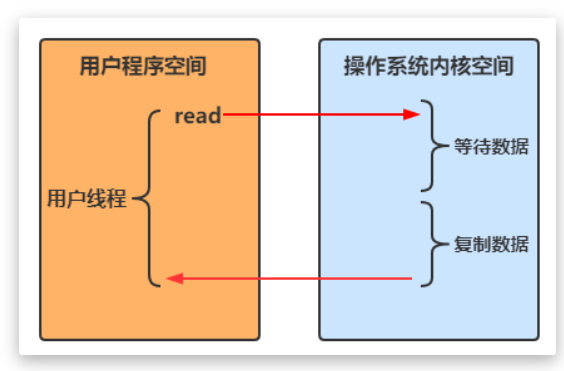
用户线程进行read操作时,需要等待操作系统执行实际的read操作,此期间用户线程是被阻塞的,无法执行其他操作
非阻塞IO
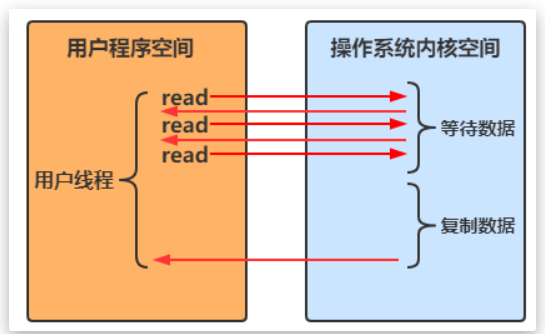
用户线程在一个循环中一直调用read方法,若内核空间中还没有数据可读,立即返回
- 只是在等待阶段非阻塞
用户线程发现内核空间中有数据后,等待内核空间执行复制数据,待复制结束后返回结果
多路复用
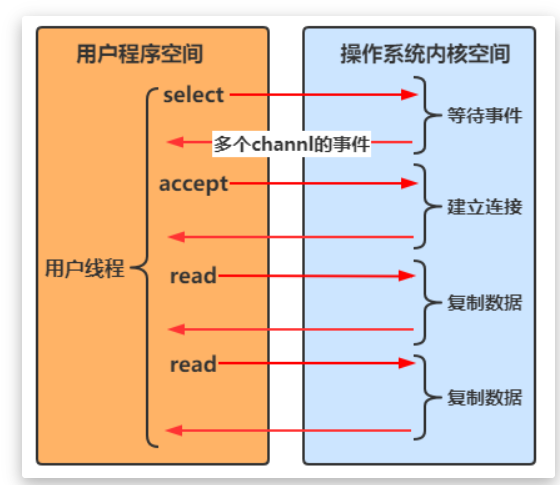
Java中通过Selector实现多路复用当没有事件是,调用select方法会被阻塞住
- 一旦有一个或多个事件发生后,就会处理对应的事件,从而实现多路复用
多路复用与阻塞IO的区别
- 阻塞IO模式下,若线程因accept事件被阻塞,发生read事件后,仍需等待accept事件执行完成后,才能去处理read事件
多路复用模式下,一个事件发生后,若另一个事件处于阻塞状态,不会影响该事件的执行
异步IO
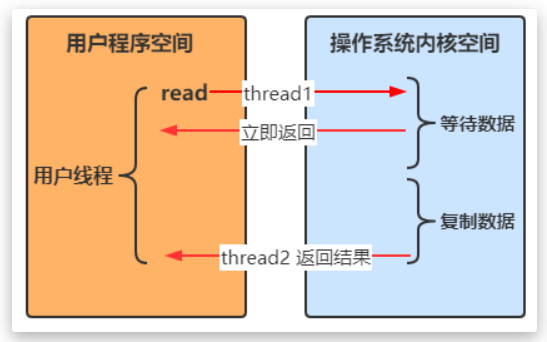
线程1调用方法后理解返回,不会被阻塞也不需要立即获取结果
-
4.3、零拷贝
零拷贝指的是数据无需拷贝到 JVM 内存中,同时具有以下三个优点
更少的用户态与内核态的切换
- 不利用 cpu 计算,减少 cpu 缓存伪共享
- 零拷贝适合小文件传输
传统 IO 问题
传统的 IO 将一个文件通过 socket 写出 ```java File f = new File(“helloword/data.txt”); RandomAccessFile file = new RandomAccessFile(file, “r”);
byte[] buf = new byte[(int)f.length()]; file.read(buf);
Socket socket = …; socket.getOutputStream().write(buf);
**内部工作流如下**<br />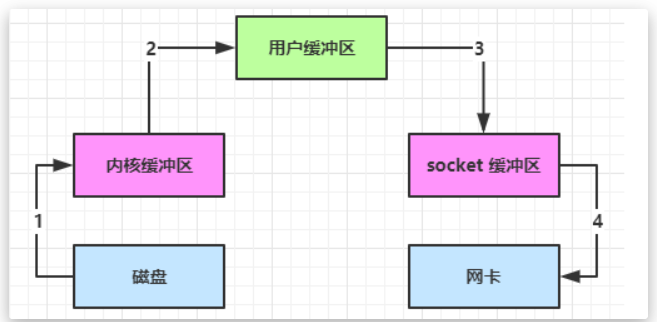- Java 本身并不具备 IO 读写能力,因此 read 方法调用后,要从 Java 程序的**用户态切换至内核态**,去调用操作系统(Kernel)的读能力,将数据读入**内核缓冲区**。这期间用户线程阻塞,操作系统使用 DMA(Direct Memory Access)来实现文件读,其间也不会使用 CPUDMA 也可以理解为硬件单元,用来解放 cpu 完成文件 IO- 从**内核态**切换回**用户态**,将数据从**内核缓冲区**读入**用户缓冲区**(即 byte[] buf),这期间 **CPU 会参与拷贝**,无法利用 DMA- 调用 write 方法,这时将数据从**用户缓冲区**(byte[] buf)写入 **socket 缓冲区,CPU 会参与拷贝**- 接下来要向网卡写数据,这项能力 Java 又不具备,因此又得从**用户态**切换至**内核态**,调用操作系统的写能力,使用 DMA 将 **socket 缓冲区**的数据写入网卡,不会使用 CPU可以看到中间环节较多,java 的 IO 实际不是物理设备级别的读写,而是缓存的复制,底层的真正读写是操作系统来完成的- 用户态与内核态的切换发生了 3 次,这个操作比较重量级- 数据拷贝了共 4 次<a name="Z2LLW"></a>#### NIO 优化通过 **DirectByteBuf**- ByteBuffer.allocate(10)- 底层对应 HeapByteBuffer,使用的还是 Java 内存- ByteBuffer.**allocateDirect**(10)- 底层对应DirectByteBuffer,**使用的是操作系统内存**<br />大部分步骤与优化前相同,唯有一点:**Java 可以使用 DirectByteBuffer 将堆外内存映射到 JVM 内存中来直接访问使用**- 这块内存不受 JVM 垃圾回收的影响,因此内存地址固定,有助于 IO 读写- Java 中的 DirectByteBuf 对象仅维护了此内存的虚引用,内存回收分成两步- DirectByteBuffer 对象被垃圾回收,将虚引用加入引用队列- 当引用的对象ByteBuffer被垃圾回收以后,虚引用对象Cleaner就会被放入引用队列中,然后调用Cleaner的clean方法来释放直接内存- DirectByteBuffer 的释放底层调用的是 Unsafe 的 freeMemory 方法- 通过专门线程访问引用队列,根据虚引用释放堆外内存- **减少了一次数据拷贝,用户态与内核态的切换次数没有减少**<a name="uReb4"></a>#### 进一步优化1**以下两种方式都是零拷贝**,即无需将数据拷贝到用户缓冲区中(JVM内存中)<br />底层采用了 **linux 2.1** 后提供的 **sendFile** 方法,Java 中对应着两个 channel 调用 **transferTo/transferFrom** 方法拷贝数据<br />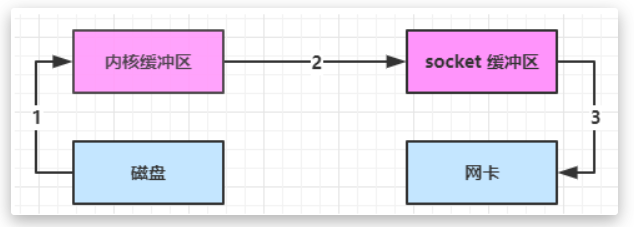- Java 调用 transferTo 方法后,要从 Java 程序的**用户态**切换至**内核态**,使用 DMA将数据读入**内核缓冲区**,不会使用 CPU- 数据从**内核缓冲区**传输到 **socket 缓冲区**,CPU 会参与拷贝- 最后使用 DMA 将 **socket 缓冲区**的数据写入网卡,不会使用 CPU这种方法下- 只发生了1次用户态与内核态的切换- 数据拷贝了 3 次<a name="q1tbY"></a>#### 进一步优化2**linux 2.4** 对上述方法再次进行了优化<br />- Java 调用 **transferTo **方法后,要从 Java 程序的**用户态**切换至**内核态**,使用 DMA将数据读入**内核缓冲区**,不会使用 CPU- 只会将一些 offset 和 length 信息拷入 **socket 缓冲区**,几乎无消耗- 使用 DMA 将 **内核缓冲区**的数据写入网卡,不会使用 CPU**整个过程仅只发生了1次用户态与内核态的切换,数据拷贝了 2 次**<a name="RxLe9"></a>### 4.4、AIOAIO 用来解决数据复制阶段的阻塞问题- 同步意味着,在进行读写操作时,线程需要等待结果,还是相当于闲置- 异步意味着,在进行读写操作时,线程不必等待结果,而是将来由操作系统来通过回调方式由另外的线程来获得结果异步模型需要底层操作系统(Kernel)提供支持- Windows 系统通过 IOCP **实现了真正的异步 IO**- Linux 系统异步 IO 在 2.6 版本引入,但其**底层实现还是用多路复用模拟了异步 IO,性能没有优势**<a name="Bfi2d"></a>## 5、Netty<a name="kiVLF"></a>### 5.1、概述<a name="envyV"></a>#### 1、什么是Netty`Netty is an asynchronous event-driven network application framework for rapid development of maintainable high performance protocol servers & clients.`<br />Netty 是一个异步的、基于事件驱动的网络应用框架,用于快速开发可维护、高性能的网络服务器和客户端<br />**注意**:netty的异步还是基于多路复用的,并没有实现真正意义上的异步IO<a name="X2ivF"></a>#### 2、Netty的优势如果使用传统NIO,其工作量大,bug 多- 需要自己构建协议- 解决 TCP 传输问题,如粘包、半包- 因为bug的存在,epoll 空轮询导致 CPU 100%Netty 对 API 进行增强,使之更易用,如- FastThreadLocal => ThreadLocal- ByteBuf => ByteBuffer<a name="F2iH9"></a>### 5.2、入门案例<a name="JLBhy"></a>#### 1、服务端代码```javapublic class HelloServer {public static void main(String[] args) {// 1、启动器,负责装配netty组件,启动服务器new ServerBootstrap()// 2、创建 NioEventLoopGroup,可以简单理解为 线程池 + Selector.group(new NioEventLoopGroup())// 3、选择服务器的 ServerSocketChannel 实现.channel(NioServerSocketChannel.class)// 4、child 负责处理读写,该方法决定了 child 执行哪些操作// ChannelInitializer 处理器(仅执行一次)// 它的作用是待客户端SocketChannel建立连接后,执行initChannel以便添加更多的处理器.childHandler(new ChannelInitializer<NioSocketChannel>() {@Overrideprotected void initChannel(NioSocketChannel nioSocketChannel) throws Exception {// 5、SocketChannel的处理器,使用StringDecoder解码,ByteBuf=>StringnioSocketChannel.pipeline().addLast(new StringDecoder());// 6、SocketChannel的业务处理,使用上一个处理器的处理结果nioSocketChannel.pipeline().addLast(new SimpleChannelInboundHandler<String>() {@Overrideprotected void channelRead0(ChannelHandlerContext channelHandlerContext, String s) throws Exception {System.out.println(s);}});}// 7、ServerSocketChannel绑定8080端口}).bind(8080);}}
2、客户端代码
public class HelloClient {public static void main(String[] args) throws InterruptedException {new Bootstrap().group(new NioEventLoopGroup())// 选择客户 Socket 实现类,NioSocketChannel 表示基于 NIO 的客户端实现.channel(NioSocketChannel.class)// ChannelInitializer 处理器(仅执行一次)// 它的作用是待客户端SocketChannel建立连接后,执行initChannel以便添加更多的处理器.handler(new ChannelInitializer<Channel>() {@Overrideprotected void initChannel(Channel channel) throws Exception {// 消息会经过通道 handler 处理,这里是将 String => ByteBuf 编码发出channel.pipeline().addLast(new StringEncoder());}})// 指定要连接的服务器和端口.connect(new InetSocketAddress("localhost", 8080))// Netty 中很多方法都是异步的,如 connect// 这时需要使用 sync 方法等待 connect 建立连接完毕.sync()// 获取 channel 对象,它即为通道抽象,可以进行数据读写操作.channel()// 写入消息并清空缓冲区.writeAndFlush("hello world");}}
3、运行流程
左:客户端 右:服务器端
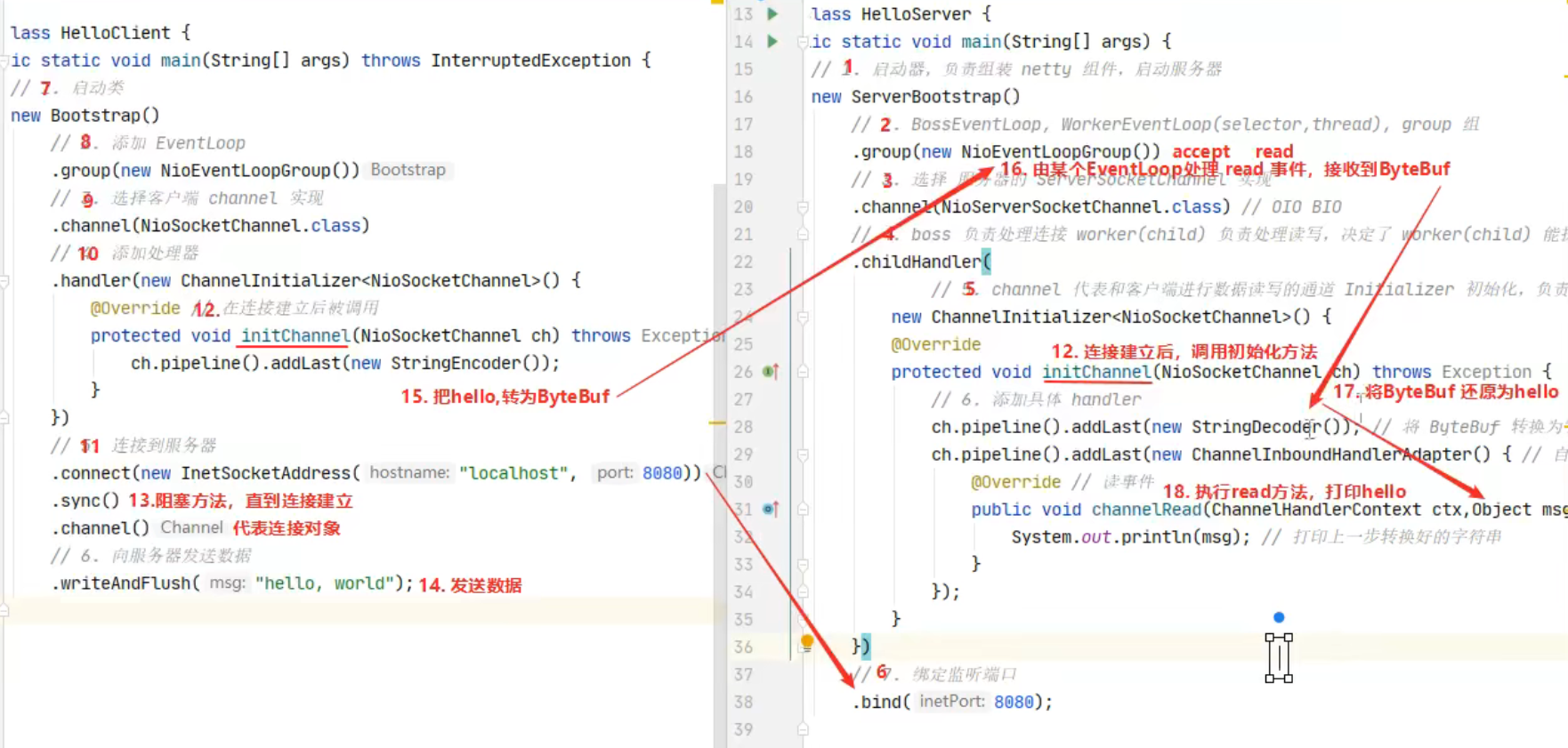
组件解释
- channel 可以理解为数据的通道
- msg 理解为流动的数据,最开始输入是 ByteBuf,但经过 pipeline 中的各个 handler 加工,会变成其它类型对象,最后输出又变成 ByteBuf
- handler 可以理解为数据的处理工序
- 工序有多道,合在一起就是 pipeline(传递途径),pipeline 负责发布事件(读、读取完成…)传播给每个 handler, handler 对自己感兴趣的事件进行处理(重写了相应事件处理方法)
- pipeline 中有多个 handler,处理时会依次调用其中的 handler
- handler 分 Inbound 和 Outbound 两类
- Inbound 入站
- Outbound 出站
- 工序有多道,合在一起就是 pipeline(传递途径),pipeline 负责发布事件(读、读取完成…)传播给每个 handler, handler 对自己感兴趣的事件进行处理(重写了相应事件处理方法)
eventLoop 可以理解为处理数据的工人
- eventLoop 可以管理多个 channel 的 io 操作,并且一旦 eventLoop 负责了某个 channel,就会将其与channel进行绑定,以后该 channel 中的 io 操作都由该 eventLoop 负责
- eventLoop 既可以执行 io 操作,也可以进行任务处理,每个 eventLoop 有自己的任务队列,队列里可以堆放多个 channel 的待处理任务,任务分为普通任务、定时任务
- eventLoop 按照 pipeline 顺序,依次按照 handler 的规划(代码)处理数据,可以为每个 handler 指定不同的 eventLoop
5.3、组件
1、EventLoop
事件循环对象 EventLoop
EventLoop 本质是一个单线程执行器(同时维护了一个 Selector),里面有 run 方法处理一个或多个 Channel 上源源不断的 io 事件
它的继承关系如下
继承自 j.u.c.ScheduledExecutorService 因此包含了线程池中所有的方法
- 继承自 netty 自己的 OrderedEventExecutor
- 提供了 boolean inEventLoop(Thread thread) 方法判断一个线程是否属于此 EventLoop
- 提供了 EventLoopGroup parent() 方法来看看自己属于哪个 EventLoopGroup
事件循环组 EventLoopGroup
EventLoopGroup 是一组 EventLoop,Channel 一般会调用 EventLoopGroup 的 register 方法来绑定其中一个 EventLoop,后续这个 Channel 上的 io 事件都由此 EventLoop 来处理(保证了 io 事件处理时的线程安全)
继承自 netty 自己的 EventExecutorGroup
- 实现了 Iterable 接口提供遍历 EventLoop 的能力
-
处理普通与定时任务
public class TestEventLoop {public static void main(String[] args) {// 创建拥有两个EventLoop的NioEventLoopGroup,对应两个线程EventLoopGroup group = new NioEventLoopGroup(2);// 通过next方法可以获得下一个 EventLoopSystem.out.println(group.next());System.out.println(group.next());// 通过EventLoop执行普通任务group.next().execute(()->{System.out.println(Thread.currentThread().getName() + " hello");});// 通过EventLoop执行定时任务group.next().scheduleAtFixedRate(()->{System.out.println(Thread.currentThread().getName() + " hello2");}, 0, 1, TimeUnit.SECONDS);// 优雅地关闭group.shutdownGracefully();}}
输出结果如下
io.netty.channel.nio.NioEventLoop@7bb11784io.netty.channel.nio.NioEventLoop@33a10788nioEventLoopGroup-2-1 hellonioEventLoopGroup-2-2 hello2nioEventLoopGroup-2-2 hello2nioEventLoopGroup-2-2 hello2
关闭 EventLoopGroup
优雅关闭 shutdownGracefully 方法。该方法会首先切换 EventLoopGroup 到关闭状态从而拒绝新的任务的加入,然后在任务队列的任务都处理完成后,停止线程的运行。从而确保整体应用是在正常有序的状态下退出的处理IO任务
服务器代码
public class MyServer {public static void main(String[] args) {new ServerBootstrap().group(new NioEventLoopGroup()).channel(NioServerSocketChannel.class).childHandler(new ChannelInitializer<SocketChannel>() {@Overrideprotected void initChannel(SocketChannel socketChannel) throws Exception {socketChannel.pipeline().addLast(new ChannelInboundHandlerAdapter() {@Overridepublic void channelRead(ChannelHandlerContext ctx, Object msg) throws Exception {ByteBuf buf = (ByteBuf) msg;System.out.println(Thread.currentThread().getName() + " " + buf.toString(StandardCharsets.UTF_8));}});}}).bind(8080);}}
客户端代码
public class MyClient {public static void main(String[] args) throws IOException, InterruptedException {Channel channel = new Bootstrap().group(new NioEventLoopGroup()).channel(NioSocketChannel.class).handler(new ChannelInitializer<SocketChannel>() {@Overrideprotected void initChannel(SocketChannel socketChannel) throws Exception {socketChannel.pipeline().addLast(new StringEncoder());}}).connect(new InetSocketAddress("localhost", 8080)).sync().channel();System.out.println(channel);// 此处打断点调试,调用 channel.writeAndFlush(...);System.in.read();}}
分工
Bootstrap的group()方法可以传入两个EventLoopGroup参数,分别负责处理不同的事件
public class MyServer {public static void main(String[] args) {new ServerBootstrap()// 两个Group,分别为Boss 负责Accept事件,Worker 负责读写事件.group(new NioEventLoopGroup(1), new NioEventLoopGroup(2))...}}
多个客户端分别发送 hello 结果
nioEventLoopGroup-3-1 hello1nioEventLoopGroup-3-2 hello2nioEventLoopGroup-3-1 hello3nioEventLoopGroup-3-2 hello4nioEventLoopGroup-3-2 hello4
可以看出,一个EventLoop可以负责多个Channel,且EventLoop一旦与Channel绑定,则一直负责处理该Channel中的事件
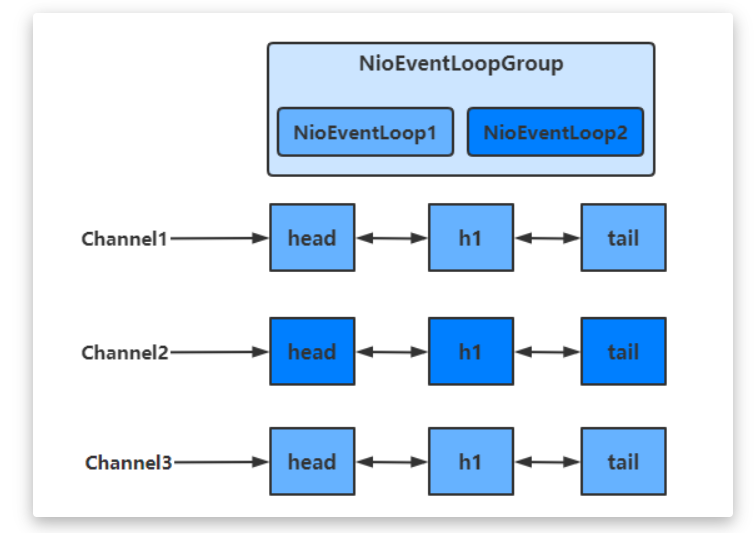
增加自定义EventLoopGroup
当有的任务需要较长的时间处理时,可以使用非NioEventLoopGroup,避免同一个NioEventLoop中的其他Channel在较长的时间内都无法得到处理public class MyServer {public static void main(String[] args) {// 增加自定义的非NioEventLoopGroupEventLoopGroup group = new DefaultEventLoopGroup();new ServerBootstrap().group(new NioEventLoopGroup(1), new NioEventLoopGroup(2)).channel(NioServerSocketChannel.class).childHandler(new ChannelInitializer<SocketChannel>() {@Overrideprotected void initChannel(SocketChannel socketChannel) throws Exception {// 增加两个handler,第一个使用NioEventLoopGroup处理,第二个使用自定义EventLoopGroup处理socketChannel.pipeline().addLast("nioHandler",new ChannelInboundHandlerAdapter() {@Overridepublic void channelRead(ChannelHandlerContext ctx, Object msg) throws Exception {ByteBuf buf = (ByteBuf) msg;System.out.println(Thread.currentThread().getName() + " " + buf.toString(StandardCharsets.UTF_8));// 调用下一个handlerctx.fireChannelRead(msg);}})// 该handler绑定自定义的Group.addLast(group, "myHandler", new ChannelInboundHandlerAdapter() {@Overridepublic void channelRead(ChannelHandlerContext ctx, Object msg) throws Exception {ByteBuf buf = (ByteBuf) msg;System.out.println(Thread.currentThread().getName() + " " + buf.toString(StandardCharsets.UTF_8));}});}}).bind(8080);}}
启动四个客户端发送数据
nioEventLoopGroup-4-1 hello1defaultEventLoopGroup-2-1 hello1nioEventLoopGroup-4-2 hello2defaultEventLoopGroup-2-2 hello2nioEventLoopGroup-4-1 hello3defaultEventLoopGroup-2-3 hello3nioEventLoopGroup-4-2 hello4defaultEventLoopGroup-2-4 hello4
可以看出,客户端与服务器之间的事件,被nioEventLoopGroup和defaultEventLoopGroup分别处理
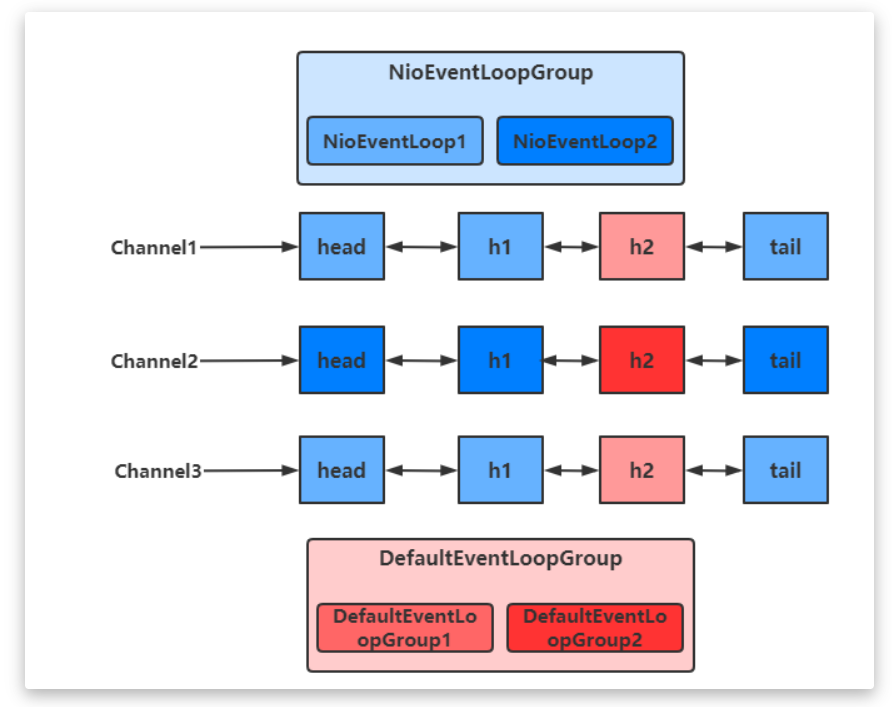
切换的实现
不同的EventLoopGroup切换的实现原理如下
由上面的图可以看出,当handler中绑定的Group不同时,需要切换Group来执行不同的任务static void invokeChannelRead(final AbstractChannelHandlerContext next, Object msg) {final Object m = next.pipeline.touch(ObjectUtil.checkNotNull(msg, "msg"), next);// 获得下一个EventLoop, excutor 即为 EventLoopGroupEventExecutor executor = next.executor();// 如果下一个EventLoop 在当前的 EventLoopGroup中if (executor.inEventLoop()) {// 使用当前 EventLoopGroup 中的 EventLoop 来处理任务next.invokeChannelRead(m);} else {// 否则让另一个 EventLoopGroup 中的 EventLoop 来创建任务并执行executor.execute(new Runnable() {public void run() {next.invokeChannelRead(m);}});}}
如果两个 handler 绑定的是同一个EventLoopGroup,那么就直接调用
否则,把要调用的代码封装为一个任务对象,由下一个 handler 的 EventLoopGroup 来调用
2、Channel
Channel 的常用方法
close() 可以用来关闭Channel
- closeFuture() 用来处理 Channel 的关闭
- sync 方法作用是同步等待 Channel 关闭
- 而 addListener 方法是异步等待 Channel 关闭
- pipeline() 方法用于添加处理器
- write() 方法将数据写入
- 因为缓冲机制,数据被写入到 Channel 中以后,不会立即被发送
- 只有当缓冲满了或者调用了flush()方法后,才会将数据通过 Channel 发送出去
writeAndFlush() 方法将数据写入并立即发送(刷出)
ChannelFuture
连接问题
拆分客户端
public class MyClient {public static void main(String[] args) throws IOException, InterruptedException {ChannelFuture channelFuture = new Bootstrap().group(new NioEventLoopGroup()).channel(NioSocketChannel.class).handler(new ChannelInitializer<SocketChannel>() {@Overrideprotected void initChannel(SocketChannel socketChannel) throws Exception {socketChannel.pipeline().addLast(new StringEncoder());}})// 该方法为异步非阻塞方法,主线程调用后不会被阻塞,真正去执行连接操作的是NIO线程// NIO线程:NioEventLoop 中的线程.connect(new InetSocketAddress("localhost", 8080));// 该方法用于等待连接真正建立channelFuture.sync();// 获取客户端-服务器之间的Channel对象Channel channel = channelFuture.channel();channel.writeAndFlush("hello world");System.in.read();}}
如果我们去掉channelFuture.sync()方法,会服务器无法收到hello world
这是因为建立连接(connect)的过程是异步非阻塞的,若不通过sync()方法阻塞主线程,等待连接真正建立,这时通过 channelFuture.channel() 拿到的 Channel 对象,并不是真正与服务器建立好连接的 Channel,也就没法将信息正确的传输给服务器端
所以需要通过channelFuture.sync()方法,阻塞主线程,同步处理结果,等待连接真正建立好以后,再去获得 Channel 传递数据。使用该方法,获取 Channel 和发送数据的线程都是主线程
下面还有一种方法,用于异步获取建立连接后的 Channel 和发送数据,使得执行这些操作的线程是 NIO 线程(去执行connect操作的线程)
addListener方法
通过这种方法可以在NIO线程中获取 Channel 并发送数据,而不是在主线程中执行这些操作public class MyClient {public static void main(String[] args) throws IOException, InterruptedException {ChannelFuture channelFuture = new Bootstrap().group(new NioEventLoopGroup()).channel(NioSocketChannel.class).handler(new ChannelInitializer<SocketChannel>() {@Overrideprotected void initChannel(SocketChannel socketChannel) throws Exception {socketChannel.pipeline().addLast(new StringEncoder());}})// 该方法为异步非阻塞方法,主线程调用后不会被阻塞,真正去执行连接操作的是NIO线程// NIO线程:NioEventLoop 中的线程.connect(new InetSocketAddress("localhost", 8080));// 当connect方法执行完毕后,也就是连接真正建立后// 会在NIO线程中调用operationComplete方法channelFuture.addListener(new ChannelFutureListener() {@Overridepublic void operationComplete(ChannelFuture channelFuture) throws Exception {Channel channel = channelFuture.channel();channel.writeAndFlush("hello world");}});System.in.read();}}
关闭处理
public class ReadClient {public static void main(String[] args) throws InterruptedException {// 创建EventLoopGroup,使用完毕后关闭NioEventLoopGroup group = new NioEventLoopGroup();ChannelFuture channelFuture = new Bootstrap().group(group).channel(NioSocketChannel.class).handler(new ChannelInitializer<SocketChannel>() {@Overrideprotected void initChannel(SocketChannel socketChannel) throws Exception {socketChannel.pipeline().addLast(new StringEncoder());}}).connect(new InetSocketAddress("localhost", 8080));channelFuture.sync();Channel channel = channelFuture.channel();Scanner scanner = new Scanner(System.in);// 创建一个线程用于输入并向服务器发送new Thread(()->{while (true) {String msg = scanner.next();if ("q".equals(msg)) {// 关闭操作是异步的,在NIO线程中执行channel.close();break;}channel.writeAndFlush(msg);}}, "inputThread").start();// 获得closeFuture对象ChannelFuture closeFuture = channel.closeFuture();System.out.println("waiting close...");// 同步等待NIO线程执行完close操作 阻塞closeFuture.sync();// 关闭之后执行一些操作,可以保证执行的操作一定是在channel关闭以后执行的System.out.println("关闭之后执行一些额外操作...");// 关闭EventLoopGroupgroup.shutdownGracefully();}}
关闭channel
当我们要关闭channel时,可以调用channel.close()方法进行关闭。但是该方法也是一个异步方法。真正的关闭操作并不是在调用该方法的线程中执行的,而是在NIO线程中执行真正的关闭操作
如果我们想在channel真正关闭以后,执行一些额外的操作,可以选择以下两种方法来实现通过channel.closeFuture()方法获得对应的ChannelFuture对象,然后调用sync()方法阻塞执行操作的线程,等待channel真正关闭后,再执行其他操作 ```java // 获得closeFuture对象 ChannelFuture closeFuture = channel.closeFuture();
// 同步等待NIO线程执行完close操作 closeFuture.sync();
- 调用**closeFuture.addListener**方法,添加close的后续操作```javacloseFuture.addListener(new ChannelFutureListener() {@Overridepublic void operationComplete(ChannelFuture channelFuture) throws Exception {// 等待channel关闭后才执行的操作System.out.println("关闭之后执行一些额外操作...");// 关闭EventLoopGroupgroup.shutdownGracefully();}});
3、Future与Promise
概念
netty 中的 Future 与 jdk 中的 Future 同名,但是是两个接口
netty 的 Future 继承自 jdk 的 Future,而 Promise 又对 netty Future 进行了扩展
- jdk Future 只能同步等待任务结束(或成功、或失败)才能得到结果
- netty Future 可以同步等待任务结束得到结果,也可以异步方式得到结果,但都是要等任务结束
- netty Promise 不仅有 netty Future 的功能,而且脱离了任务独立存在,只作为两个线程间传递结果的容器 | 功能/名称 | jdk Future | netty Future | Promise | | —- | —- | —- | —- | | cancel | 取消任务 | - | - | | isCanceled | 任务是否取消 | - | - | | isDone | 任务是否完成,不能区分成功失败 | - | - | | get | 获取任务结果,阻塞等待 | - | - | | getNow | - | 获取任务结果,非阻塞,还未产生结果时返回 null | - | | await | - | 等待任务结束,如果任务失败,不会抛异常,而是通过 isSuccess 判断 | - | | sync | - | 等待任务结束,如果任务失败,抛出异常 | - | | isSuccess | - | 判断任务是否成功 | - | | cause | - | 获取失败信息,非阻塞,如果没有失败,返回null | - | | addLinstener | - | 添加回调,异步接收结果 | - | | setSuccess | - | - | 设置成功结果 | | setFailure | - | - | 设置失败结果 |
JDK Future
public class JdkFuture {public static void main(String[] args) throws ExecutionException, InterruptedException {ThreadFactory factory = new ThreadFactory() {@Overridepublic Thread newThread(Runnable r) {return new Thread(r, "JdkFuture");}};// 创建线程池ThreadPoolExecutor executor = new ThreadPoolExecutor(5, 10,10, TimeUnit.SECONDS, new ArrayBlockingQueue<>(10), factory);// 获得Future对象Future<Integer> future = executor.submit(new Callable<Integer>() {@Overridepublic Integer call() throws Exception {TimeUnit.SECONDS.sleep(1);return 50;}});// 通过阻塞的方式,获得运行结果System.out.println(future.get());}}
Netty Future
public class NettyFuture {public static void main(String[] args) throws ExecutionException, InterruptedException {NioEventLoopGroup group = new NioEventLoopGroup();// 获得 EventLoop 对象EventLoop eventLoop = group.next();Future<Integer> future = eventLoop.submit(new Callable<Integer>() {@Overridepublic Integer call() throws Exception {return 50;}});// 主线程中获取结果System.out.println(Thread.currentThread().getName() + " 获取结果");System.out.println("getNow " + future.getNow());System.out.println("get " + future.get());// NIO线程中异步获取结果future.addListener(new GenericFutureListener<Future<? super Integer>>() {@Overridepublic void operationComplete(Future<? super Integer> future) throws Exception {System.out.println(Thread.currentThread().getName() + " 获取结果");System.out.println("getNow " + future.getNow());}});}}
运行结果
main 获取结果getNow nullget 50nioEventLoopGroup-2-1 获取结果getNow 50
Netty中的Future对象,可以通过EventLoop的sumbit()方法得到
- 可以通过Future对象的get方法,阻塞地获取返回结果
- 也可以通过getNow方法,获取结果,若还没有结果,则返回null,该方法是非阻塞的
还可以通过future.addListener方法,在Callable方法执行的线程中,异步获取返回结果
Netty Promise
Promise相当于一个容器,可以用于存放各个线程中的结果,然后让其他线程去获取该结果
public class NettyPromise {public static void main(String[] args) throws ExecutionException, InterruptedException {// 创建EventLoopNioEventLoopGroup group = new NioEventLoopGroup();EventLoop eventLoop = group.next();// 创建Promise对象,用于存放结果DefaultPromise<Integer> promise = new DefaultPromise<>(eventLoop);new Thread(()->{try {TimeUnit.SECONDS.sleep(1);} catch (InterruptedException e) {e.printStackTrace();}// 自定义线程向Promise中存放结果promise.setSuccess(50);}).start();// 主线程从Promise中获取结果System.out.println(Thread.currentThread().getName() + " " + promise.get());}}
4、Handler与Pipeline
Pipeline
public class PipeLineServer {public static void main(String[] args) {new ServerBootstrap().group(new NioEventLoopGroup()).channel(NioServerSocketChannel.class).childHandler(new ChannelInitializer<SocketChannel>() {@Overrideprotected void initChannel(SocketChannel socketChannel) throws Exception {// 在socketChannel的pipeline中添加handler// pipeline中handler是带有head与tail节点的双向链表,的实际结构为// head <-> handler1 <-> ... <-> handler4 <->tail// Inbound主要处理入站操作,一般为读操作,发生入站操作时会触发Inbound方法// 入站时,handler是从head向后调用的socketChannel.pipeline().addLast("handler1" ,new ChannelInboundHandlerAdapter() {@Overridepublic void channelRead(ChannelHandlerContext ctx, Object msg) throws Exception {System.out.println(Thread.currentThread().getName() + " Inbound handler 1");// 父类该方法内部会调用fireChannelRead// 将数据传递给下一个handlersuper.channelRead(ctx, msg);}});socketChannel.pipeline().addLast("handler2", new ChannelInboundHandlerAdapter() {@Overridepublic void channelRead(ChannelHandlerContext ctx, Object msg) throws Exception {System.out.println(Thread.currentThread().getName() + " Inbound handler 2");// 执行write操作,使得Outbound的方法能够得到调用socketChannel.writeAndFlush(ctx.alloc().buffer().writeBytes("Server...".getBytes(StandardCharsets.UTF_8)));super.channelRead(ctx, msg);}});// Outbound主要处理出站操作,一般为写操作,发生出站操作时会触发Outbound方法// 出站时,handler的调用是从tail向前调用的socketChannel.pipeline().addLast("handler3" ,new ChannelOutboundHandlerAdapter(){@Overridepublic void write(ChannelHandlerContext ctx, Object msg, ChannelPromise promise) throws Exception {System.out.println(Thread.currentThread().getName() + " Outbound handler 1");super.write(ctx, msg, promise);}});socketChannel.pipeline().addLast("handler4" ,new ChannelOutboundHandlerAdapter(){@Overridepublic void write(ChannelHandlerContext ctx, Object msg, ChannelPromise promise) throws Exception {System.out.println(Thread.currentThread().getName() + " Outbound handler 2");super.write(ctx, msg, promise);}});}}).bind(8080);}}
运行结果如下
nioEventLoopGroup-2-2 Inbound handler 1nioEventLoopGroup-2-2 Inbound handler 2nioEventLoopGroup-2-2 Outbound handler 2nioEventLoopGroup-2-2 Outbound handler 1
通过channel.pipeline().addLast(name, handler)添加handler时,记得给handler取名字。这样可以调用pipeline的addAfter、addBefore等方法更灵活地向pipeline中添加handler
handler需要放入通道的pipeline中,才能根据放入顺序来使用handlerpipeline是结构是一个带有head与tail指针的双向链表,其中的节点为handler
- 要通过ctx.fireChannelRead(msg)等方法,将当前handler的处理结果传递给下一个handler
- 当有入站(Inbound)操作时,会从head开始向后调用handler,直到handler不是处理Inbound操作为止
- 当有出站(Outbound)操作时,会从tail开始向前调用handler,直到handler不是处理Outbound操作为止
OutboundHandler
socketChannel.writeAndFlush()
当handler中调用该方法进行写操作时,会触发Outbound操作,此时是从tail向前寻找OutboundHandler
ctx.writeAndFlush()
当handler中调用该方法进行写操作时,会触发Outbound操作,此时是从当前handler向前寻找OutboundHandler
EmbeddedChannel
EmbeddedChannel可以用于测试各个handler,通过其构造函数按顺序传入需要测试handler,然后调用对应的Inbound和Outbound方法即可
public class TestEmbeddedChannel {public static void main(String[] args) {ChannelInboundHandlerAdapter h1 = new ChannelInboundHandlerAdapter() {@Overridepublic void channelRead(ChannelHandlerContext ctx, Object msg) throws Exception {System.out.println("1");super.channelRead(ctx, msg);}};ChannelInboundHandlerAdapter h2 = new ChannelInboundHandlerAdapter() {@Overridepublic void channelRead(ChannelHandlerContext ctx, Object msg) throws Exception {System.out.println("2");super.channelRead(ctx, msg);}};ChannelOutboundHandlerAdapter h3 = new ChannelOutboundHandlerAdapter() {@Overridepublic void write(ChannelHandlerContext ctx, Object msg, ChannelPromise promise) throws Exception {System.out.println("3");super.write(ctx, msg, promise);}};ChannelOutboundHandlerAdapter h4 = new ChannelOutboundHandlerAdapter() {@Overridepublic void write(ChannelHandlerContext ctx, Object msg, ChannelPromise promise) throws Exception {System.out.println("4");super.write(ctx, msg, promise);}};// 用于测试Handler的ChannelEmbeddedChannel channel = new EmbeddedChannel(h1, h2, h3, h4);// 执行Inbound操作channel.writeInbound(ByteBufAllocator.DEFAULT.buffer().writeBytes("hello".getBytes(StandardCharsets.UTF_8)));// 执行Outbound操作channel.writeOutbound(ByteBufAllocator.DEFAULT.buffer().writeBytes("hello".getBytes(StandardCharsets.UTF_8)));}}
5、ByteBuf
调试工具方法
private static void log(ByteBuf buffer) {int length = buffer.readableBytes();int rows = length / 16 + (length % 15 == 0 ? 0 : 1) + 4;StringBuilder buf = new StringBuilder(rows * 80 * 2).append("read index:").append(buffer.readerIndex()).append(" write index:").append(buffer.writerIndex()).append(" capacity:").append(buffer.capacity()).append(NEWLINE);appendPrettyHexDump(buf, buffer);System.out.println(buf.toString());}
创建
public class ByteBufStudy {
public static void main(String[] args) {
// 创建ByteBuf
ByteBuf buffer = ByteBufAllocator.DEFAULT.buffer(16);
ByteBufUtil.log(buffer);
// 向buffer中写入数据
StringBuilder sb = new StringBuilder();
for(int i = 0; i < 20; i++) {
sb.append("a");
}
buffer.writeBytes(sb.toString().getBytes(StandardCharsets.UTF_8));
// 查看写入结果
ByteBufUtil.log(buffer);
}
}
运行结果
read index:0 write index:0 capacity:16
read index:0 write index:20 capacity:64
+-------------------------------------------------+
| 0 1 2 3 4 5 6 7 8 9 a b c d e f |
+--------+-------------------------------------------------+----------------+
|00000000| 61 61 61 61 61 61 61 61 61 61 61 61 61 61 61 61 |aaaaaaaaaaaaaaaa|
|00000010| 61 61 61 61 |aaaa |
+--------+-------------------------------------------------+----------------+
ByteBuf通过ByteBufAllocator选择allocator并调用对应的buffer()方法来创建的,默认使用直接内存作为ByteBuf,容量为256个字节,可以指定初始容量的大小
当ByteBuf的容量无法容纳所有数据时,ByteBuf会进行扩容操作
如果在handler中创建ByteBuf,建议使用ChannelHandlerContext ctx.alloc().buffer()来创建
直接内存与堆内存
通过该方法创建的ByteBuf,使用的是基于直接内存的ByteBuf
ByteBuf buffer = ByteBufAllocator.DEFAULT.buffer(16);
可以使用下面的代码来创建池化基于堆的 ByteBuf
ByteBuf buffer = ByteBufAllocator.DEFAULT.heapBuffer(16);
也可以使用下面的代码来创建池化基于直接内存的 ByteBuf
ByteBuf buffer = ByteBufAllocator.DEFAULT.directBuffer(16);
- 直接内存创建和销毁的代价昂贵,但读写性能高(少一次内存复制),适合配合池化功能一起用
- 直接内存对 GC 压力小,因为这部分内存不受 JVM 垃圾回收的管理,但也要注意及时主动释放
验证
public class ByteBufStudy {
public static void main(String[] args) {
ByteBuf buffer = ByteBufAllocator.DEFAULT.buffer(16);
System.out.println(buffer.getClass());
buffer = ByteBufAllocator.DEFAULT.heapBuffer(16);
System.out.println(buffer.getClass());
buffer = ByteBufAllocator.DEFAULT.directBuffer(16);
System.out.println(buffer.getClass());
}
}
// 使用池化的直接内存
class io.netty.buffer.PooledUnsafeDirectByteBuf
// 使用池化的堆内存
class io.netty.buffer.PooledUnsafeHeapByteBuf
// 使用池化的直接内存
class io.netty.buffer.PooledUnsafeDirectByteBuf
池化与非池化
池化的最大意义在于可以重用 ByteBuf,优点有
- 没有池化,则每次都得创建新的 ByteBuf 实例,这个操作对直接内存代价昂贵,就算是堆内存,也会增加 GC 压力
- 有了池化,则可以重用池中 ByteBuf 实例,并且采用了与 jemalloc 类似的内存分配算法提升分配效率
- 高并发时,池化功能更节约内存,减少内存溢出的可能
池化功能是否开启,可以通过下面的系统环境变量来设置
-Dio.netty.allocator.type={unpooled|pooled}
- 4.1 以后,非 Android 平台默认启用池化实现,Android 平台启用非池化实现
-
组成
ByteBuf主要有以下几个组成部分
最大容量与当前容量
- 在构造ByteBuf时,可传入两个参数,分别代表初始容量和最大容量,若未传入第二个参数(最大容量),最大容量默认为Integer.MAX_VALUE
- 当ByteBuf容量无法容纳所有数据时,会进行扩容操作,若超出最大容量,会抛出java.lang.IndexOutOfBoundsException异常
- 读写操作不同于ByteBuffer只用position进行控制,ByteBuf分别由读指针和写指针两个指针控制。进行读写操作时,无需进行模式的切换
- 读指针前的部分被称为废弃部分,是已经读过的内容
- 读指针与写指针之间的空间称为可读部分
- 写指针与当前容量之间的空间称为可写部分
写入
常用方法如下
| 方法签名 | 含义 | 备注 |
|---|---|---|
| writeBoolean(boolean value) | 写入 boolean 值 | 用一字节 01|00 代表 true|false |
| writeByte(int value) | 写入 byte 值 | |
| writeShort(int value) | 写入 short 值 | |
| writeInt(int value) | 写入 int 值 | Big Endian(大端写入),即 0x250,写入后 00 00 02 50 |
| writeIntLE(int value) | 写入 int 值 | Little Endian(小端写入),即 0x250,写入后 50 02 00 00 |
| writeLong(long value) | 写入 long 值 | |
| writeChar(int value) | 写入 char 值 | |
| writeFloat(float value) | 写入 float 值 | |
| writeDouble(double value) | 写入 double 值 | |
| writeBytes(ByteBuf src) | 写入 netty 的 ByteBuf | |
| writeBytes(byte[] src) | 写入 byte[] | |
| writeBytes(ByteBuffer src) | 写入 nio 的 ByteBuffer | |
| int writeCharSequence(CharSequence sequence, Charset charset) | 写入字符串 | CharSequence为字符串类的父类,第二个参数为对应的字符集 |
注意
- 这些方法的未指明返回值的,其返回值都是 ByteBuf,意味着可以链式调用来写入不同的数据
- 网络传输中,默认习惯是 Big Endian,使用 writeInt(int value)
使用方法
public class ByteBufStudy {
public static void main(String[] args) {
// 创建ByteBuf
ByteBuf buffer = ByteBufAllocator.DEFAULT.buffer(16, 20);
ByteBufUtil.log(buffer);
// 向buffer中写入数据
buffer.writeBytes(new byte[]{1, 2, 3, 4});
ByteBufUtil.log(buffer);
buffer.writeInt(5);
ByteBufUtil.log(buffer);
buffer.writeIntLE(6);
ByteBufUtil.log(buffer);
buffer.writeLong(7);
ByteBufUtil.log(buffer);
}
}
运行结果
read index:0 write index:0 capacity:16
read index:0 write index:4 capacity:16
+-------------------------------------------------+
| 0 1 2 3 4 5 6 7 8 9 a b c d e f |
+--------+-------------------------------------------------+----------------+
|00000000| 01 02 03 04 |.... |
+--------+-------------------------------------------------+----------------+
read index:0 write index:8 capacity:16
+-------------------------------------------------+
| 0 1 2 3 4 5 6 7 8 9 a b c d e f |
+--------+-------------------------------------------------+----------------+
|00000000| 01 02 03 04 00 00 00 05 |........ |
+--------+-------------------------------------------------+----------------+
read index:0 write index:12 capacity:16
+-------------------------------------------------+
| 0 1 2 3 4 5 6 7 8 9 a b c d e f |
+--------+-------------------------------------------------+----------------+
|00000000| 01 02 03 04 00 00 00 05 06 00 00 00 |............ |
+--------+-------------------------------------------------+----------------+
read index:0 write index:20 capacity:20
+-------------------------------------------------+
| 0 1 2 3 4 5 6 7 8 9 a b c d e f |
+--------+-------------------------------------------------+----------------+
|00000000| 01 02 03 04 00 00 00 05 06 00 00 00 00 00 00 00 |................|
|00000010| 00 00 00 07 |.... |
+--------+-------------------------------------------------+----------------+
还有一类方法是 set 开头的一系列方法,也可以写入数据,但不会改变写指针位置
扩容
当ByteBuf中的容量无法容纳写入的数据时,会进行扩容操作
buffer.writeLong(7);
ByteBufUtil.log(buffer);
// 扩容前
read index:0 write index:12 capacity:16
...
// 扩容后
read index:0 write index:20 capacity:20
+-------------------------------------------------+
| 0 1 2 3 4 5 6 7 8 9 a b c d e f |
+--------+-------------------------------------------------+----------------+
|00000000| 01 02 03 04 00 00 00 05 06 00 00 00 00 00 00 00 |................|
|00000010| 00 00 00 07 |.... |
+--------+-------------------------------------------------+----------------+
扩容规则
- 如何写入后数据大小未超过 512 字节,则选择下一个 16 的整数倍进行扩容
- 例如写入后大小为 12 字节,则扩容后 capacity 是 16 字节
- 如果写入后数据大小超过 512 字节,则选择下一个 2n
- 例如写入后大小为 513 字节,则扩容后 capacity 是 210=1024 字节(29=512 已经不够了)
扩容不能超过 maxCapacity,否则会抛出java.lang.IndexOutOfBoundsException异常
Exception in thread "main" java.lang.IndexOutOfBoundsException: writerIndex(20) + minWritableBytes(8) exceeds maxCapacity(20): PooledUnsafeDirectByteBuf(ridx: 0, widx: 20, cap: 20/20) ...读取
读取主要是通过一系列read方法进行读取,读取时会根据读取数据的字节数移动读指针
如果需要重复读取,需要调用buffer.markReaderIndex()对读指针进行标记,并通过buffer.resetReaderIndex()将读指针恢复到mark标记的位置public class ByteBufStudy { public static void main(String[] args) { // 创建ByteBuf ByteBuf buffer = ByteBufAllocator.DEFAULT.buffer(16, 20); // 向buffer中写入数据 buffer.writeBytes(new byte[]{1, 2, 3, 4}); buffer.writeInt(5); // 读取4个字节 System.out.println(buffer.readByte()); System.out.println(buffer.readByte()); System.out.println(buffer.readByte()); System.out.println(buffer.readByte()); ByteBufUtil.log(buffer); // 通过mark与reset实现重复读取 buffer.markReaderIndex(); System.out.println(buffer.readInt()); ByteBufUtil.log(buffer); // 恢复到mark标记处 buffer.resetReaderIndex(); ByteBufUtil.log(buffer); } }```java 1 2 3 4 read index:4 write index:8 capacity:16
+-------------------------------------------------+ | 0 1 2 3 4 5 6 7 8 9 a b c d e f |+————+————————————————————————-+————————+ |00000000| 00 00 00 05 |…. | +————+————————————————————————-+————————+ 5 read index:8 write index:8 capacity:16
read index:4 write index:8 capacity:16 +————————————————————————-+ | 0 1 2 3 4 5 6 7 8 9 a b c d e f | +————+————————————————————————-+————————+ |00000000| 00 00 00 05 |…. | +————+————————————————————————-+————————+
还有以 get 开头的一系列方法,这些**方法不会改变读指针的位置**
<a name="XoCEV"></a>
#### 释放
由于 Netty 中有堆外内存(直接内存)的 ByteBuf 实现,**堆外内存最好是手动来释放**,而不是等 GC 垃圾回收。
- UnpooledHeapByteBuf 使用的是 JVM 内存,只需等 GC 回收内存即可
- UnpooledDirectByteBuf 使用的就是直接内存了,需要特殊的方法来回收内存
- PooledByteBuf 和它的子类使用了池化机制,需要更复杂的规则来回收内存
Netty 这里采用了引用计数法来控制回收内存,每个 ByteBuf 都实现了 ReferenceCounted 接口
- 每个 ByteBuf 对象的初始计数为 1
- 调用 release 方法计数减 1,如果计数为 0,ByteBuf 内存被回收
- 调用 retain 方法计数加 1,表示调用者没用完之前,其它 handler 即使调用了 release 也不会造成回收
- 当计数为 0 时,底层内存会被回收,这时即使 ByteBuf 对象还在,其各个方法均无法正常使用
<a name="SW0iT"></a>
#### 释放规则
因为 pipeline 的存在,一般需要将 ByteBuf 传递给下一个 ChannelHandler,如果在每个 ChannelHandler 中都去调用 release ,就失去了传递性(如果在这个 ChannelHandler 内这个 ByteBuf 已完成了它的使命,那么便无须再传递)<br />**基本规则是,谁是最后使用者,谁负责 release**
- 起点,对于 NIO 实现来讲,在 io.netty.channel.nio.AbstractNioByteChannel.NioByteUnsafe.read 方法中首次创建 ByteBuf 放入 pipeline(line 163 pipeline.fireChannelRead(byteBuf))
- 入站 ByteBuf 处理原则
- 对原始 ByteBuf 不做处理,调用 ctx.fireChannelRead(msg) 向后传递,这时无须 release
- **将原始 ByteBuf 转换为其它类型的 Java 对象,这时 ByteBuf 就没用了,必须 release**
- **如果不调用 ctx.fireChannelRead(msg) 向后传递,那么也必须 release**
- **注意各种异常,如果 ByteBuf 没有成功传递到下一个 ChannelHandler,必须 release**
- 假设消息**一直向后传**,那么 TailContext 会负责释放未处理消息(原始的 ByteBuf)
- 出站 ByteBuf 处理原则
- **出站消息最终都会转为 ByteBuf 输出,一直向前传,由 HeadContext flush 后 release**
- 异常处理原则
- 有时候不清楚 ByteBuf 被引用了多少次,但又必须彻底释放,可以**循环调用 release 直到返回 **
```java
while (!buffer.release()) {}
当ByteBuf被传到了pipeline的head与tail时,ByteBuf会被其中的方法彻底释放,但前提是ByteBuf被传递到了head与tail中
TailConext中释放ByteBuf的源码
protected void onUnhandledInboundMessage(Object msg) {
try {
logger.debug("Discarded inbound message {} that reached at the tail of the pipeline. Please check your pipeline configuration.", msg);
} finally {
// 具体的释放方法
ReferenceCountUtil.release(msg);
}
}
判断传过来的是否为ByteBuf,是的话才需要释放
public static boolean release(Object msg) {
return msg instanceof ReferenceCounted ? ((ReferenceCounted)msg).release() : false;
}
切片
ByteBuf切片是【零拷贝】的体现之一,对原始 ByteBuf 进行切片成多个 ByteBuf,切片后的 ByteBuf 并没有发生内存复制,还是使用原始 ByteBuf 的内存,切片后的 ByteBuf 维护独立的 read,write 指针
得到分片后的buffer后,要调用其retain方法,使其内部的引用计数加一。避免原ByteBuf释放,导致切片buffer无法使用
修改原ByteBuf中的值,也会影响切片后得到的ByteBuf
public class TestSlice {
public static void main(String[] args) {
// 创建ByteBuf
ByteBuf buffer = ByteBufAllocator.DEFAULT.buffer(16, 20);
// 向buffer中写入数据
buffer.writeBytes(new byte[]{1, 2, 3, 4, 5, 6, 7, 8, 9, 10});
// 将buffer分成两部分
ByteBuf slice1 = buffer.slice(0, 5);
ByteBuf slice2 = buffer.slice(5, 5);
// 需要让分片的buffer引用计数加一
// 避免原Buffer释放导致分片buffer无法使用
slice1.retain();
slice2.retain();
ByteBufUtil.log(slice1);
ByteBufUtil.log(slice2);
// 更改原始buffer中的值
System.out.println("===========修改原buffer中的值===========");
buffer.setByte(0,5);
System.out.println("===========打印slice1===========");
ByteBufUtil.log(slice1);
}
}
运行结果
read index:0 write index:5 capacity:5
+-------------------------------------------------+
| 0 1 2 3 4 5 6 7 8 9 a b c d e f |
+--------+-------------------------------------------------+----------------+
|00000000| 01 02 03 04 05 |..... |
+--------+-------------------------------------------------+----------------+
read index:0 write index:5 capacity:5
+-------------------------------------------------+
| 0 1 2 3 4 5 6 7 8 9 a b c d e f |
+--------+-------------------------------------------------+----------------+
|00000000| 06 07 08 09 0a |..... |
+--------+-------------------------------------------------+----------------+
===========修改原buffer中的值===========
===========打印slice1===========
read index:0 write index:5 capacity:5
+-------------------------------------------------+
| 0 1 2 3 4 5 6 7 8 9 a b c d e f |
+--------+-------------------------------------------------+----------------+
|00000000| 05 02 03 04 05 |..... |
+--------+-------------------------------------------------+----------------+
优势
- 池化思想 - 可以重用池中 ByteBuf 实例,更节约内存,减少内存溢出的可能
- 读写指针分离,不需要像 ByteBuffer 一样切换读写模式
- 可以自动扩容
- 支持链式调用,使用更流畅
- 很多地方体现零拷贝,例如
- slice、duplicate、CompositeByteBuf
